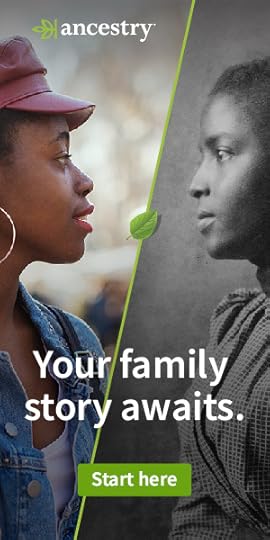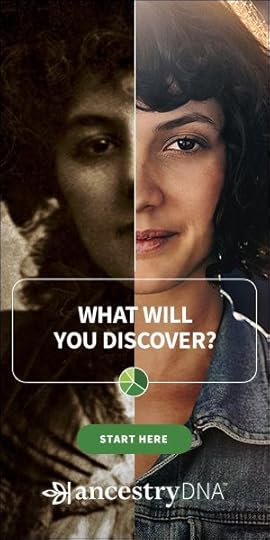Arlene Stafford-Wilson's Blog, page 38
November 9, 2021
Norvic Lodge, Christie Lake

Norvic Lodge
Victor Lemieux and his wife Noreen (McGlade) Lemieux were owners and operators of Norivc Lodge. Like the other properties set along the shores of Christie Lake, they had a beautiful shoreline, framing their homey, rustic lodge.
Victor, son of Jeremie Lemieux, and Margaret Hannah James, was born and raised in the tiny village of Fournier, in the township of Prescott-Russell. The village is situated near the communities of Vankleek Hill, St. Isidore, and Plantagenet, a largely French-Canadian settlement. Victor’s father was a Lumberman, and his mother cared for the large family.
Victor’s wife, Noreen, grew up in the town of Perth, Ontario, the daughter of Arthur McGlade. The McGlade family were early settlers from Perth, originally from County Armagh, Ireland. Catherine McCarthy McGlade, Noreen’s mother, was also from an Irish pioneer family, from County Cork. Noreen’s parents were married in Toledo, Ontario, October 16, 1899.
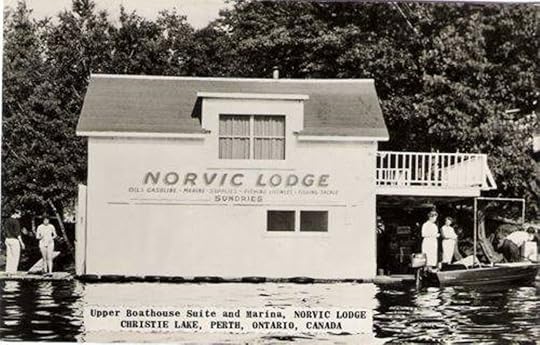
Norvic Lodge Boathouse, 1956
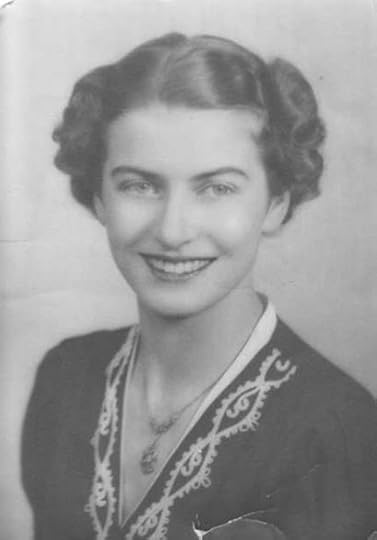
Noreen ‘Neen’ ‘Neena’ McGlade Lemiuex, Co-Owner, Norvic Lodge
Dining Room
at Norvic Lodge

Dining Room, Norvic Lodge, overlooking Christie Lake – c 1960
Working at
Norvic Lodge
Memories of working at Norvic Lodge in 1960, as told by Judy (Stafford) Ryan:
“The Lodge was ‘Norvic” named after the owners – Noreen and Vic. She was called Neena, ‘Neen’, and they had a daughter Judy, – about my age at the time. The Lodge was on Christie Lake.
I was the only one in our family who had the job there, but because I also had a two week job at the Optometrist in Perth, while his secretary was on vacation, at the beginning of the Summer (Dad got it for me), my sister Jackie (Stafford) Wharton, went up to the Lodge, and held my job for me for that two week period. I think Dad was also the one who got me the job at the Lodge. Mother did not want me to go as she figured I would get ‘into trouble’.
We were paid $10.00 a week which was given to us at the end of the Summer. We made great tips from the Americans, who stayed in the cabins – I could make up to $100.00 a week, depending on whether or not the cabins were full that week.
Our cabin was at the top of a hill away from the vacationers. Our day started at 7:00 a.m. We had to be down the hill to the Lodge in uniform, to set up the dining room for breakfast, take breakfast orders, serve it, clear tables and help wash dishes, etc. We then went back up the hill, changed into shorts and t-shirts and cleaned all the cabins – made beds, dusted, vacuumed, cleaned bathrooms, changed towels, etc. Then, back up the hill, back into uniform, to do the lunch thing.
We were supposed to have a couple of hours off each afternoon, to do what we wanted. However, part way through the summer, the lady who did the laundry left, and that was added to our jobs, without extra pay. So after lunch, we would have to do the laundry – sheets, towels, etc. and hang them out on a line to dry. Once a week, we would have to strip the beds, but changed the towels often.
On days when we didn’t have to do the laundry, I would take the canoe, and a good book, and head for a small uninhabited island, and read for a couple of hours. I knew that no-one could get to me there.
Between 4:00 and 5:00 p.m. we were back down the hill, in our uniforms, to set up for dinner, etc., etc.
After everything was done, and cleaned up for the evening, we had time to ourselves, if we had any energy left. I worked with a girl by the name of Claudette, and she was a real party girl, and as there was a party at some cottage every night, we went out most nights, along with the guy who worked at the Lodge store and gas bar, and he was allowed to use one of the motor boats, and that is how we got to the other cottages.
Just before I arrived to work at the Lodge that Summer there had been a bad boating accident, and I think one or two people had died. The only way I found out about it was I saw a mangled boat with blood on it, stored in behind the lodge, when I was out walking one day, and asked the guy at the gas bar what happened.
That Summer was the first time I saw death! There was a delightful family from Pennsylvania. there – three generations – Grandfather, parents, and two younger children. I was serving breakfast this one morning, and the Grandfather, who was always so friendly and animated, told me about the different birds he had heard singing that morning, and during the conversation, he keeled over at the table. I ran into the kitchen and got Vic (Lemieux) – told him the old man ‘fainted’. Vic got the son to help him carry the Grandfather into the Lounge, behind the dining room, and they put him on the couch. I remember going ahead and serving the other guests, and noticed people coming and going to the Lounge. Nina told me later that the old guy had died, probably instantly, and I was really shocked and upset. That is one of those memories that is permanently etched in your memory, especially when you are only 15.”

Norvic Lodge ad – 1971

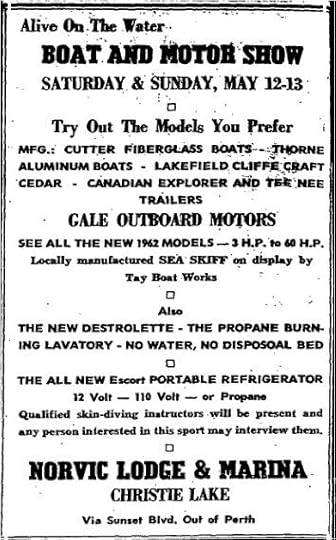
Ad – 1962
Waterskiing
at Norvic Lodge
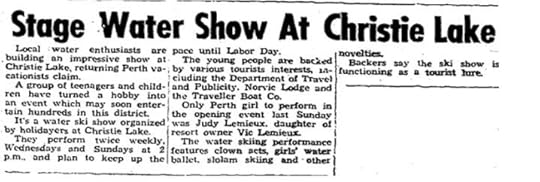
Waterskiing Show 1963
Christie Lake Surfers
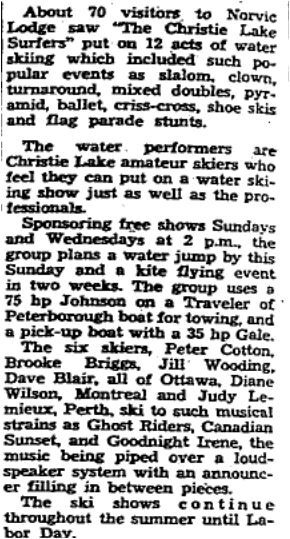

What became of Norvic Lodge?
Norvic Lodge closed many years ago, and so we are left with our memories of this special place – the home-cooked meals, Vic, Neena, the peaceful lake, the great fishing, and the excitement of the water-skiing shows will stay with us always.

November 8, 2021
WWII Soldiers from Perth and Area
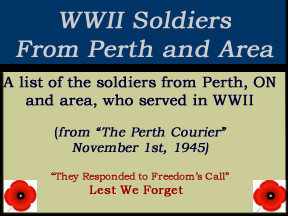


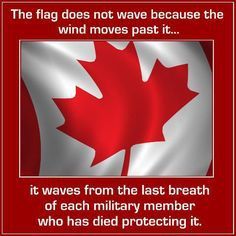


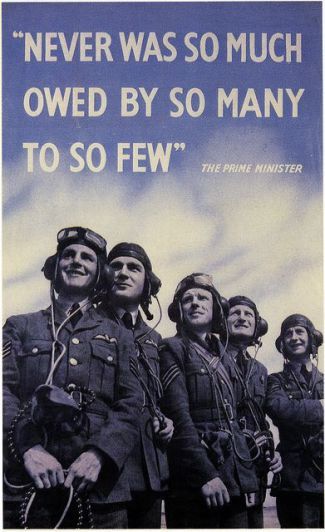
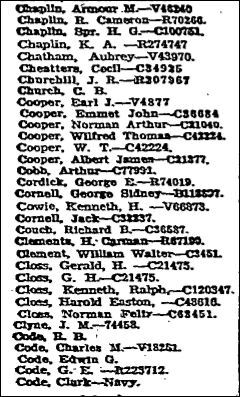

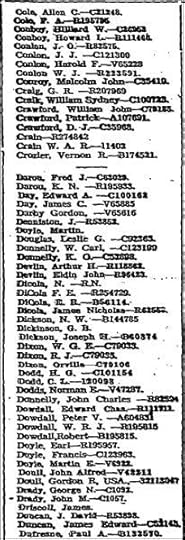
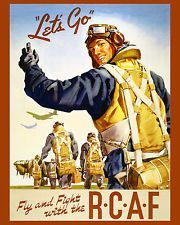

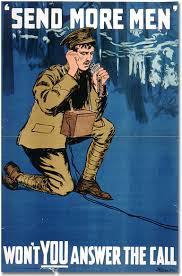
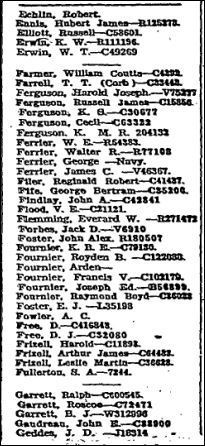
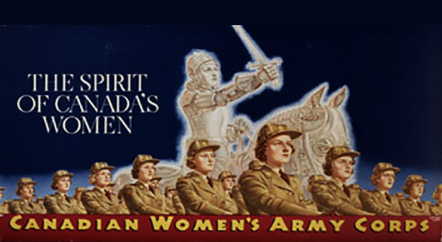

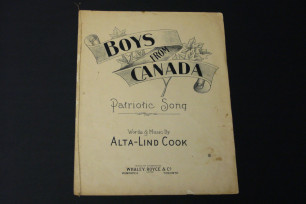
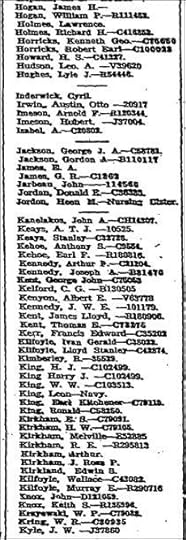
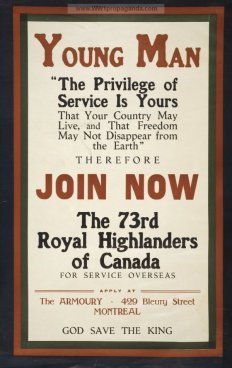
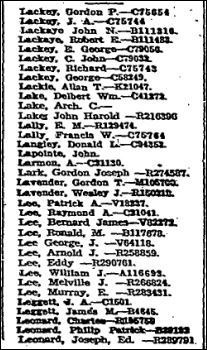
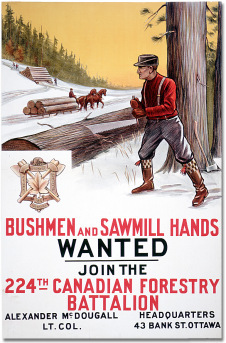
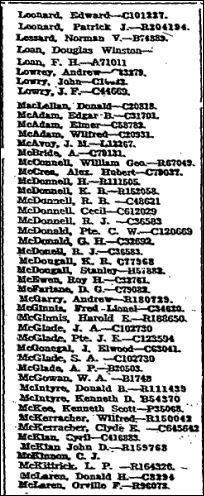
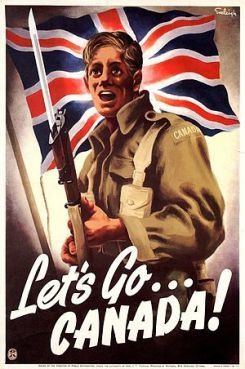
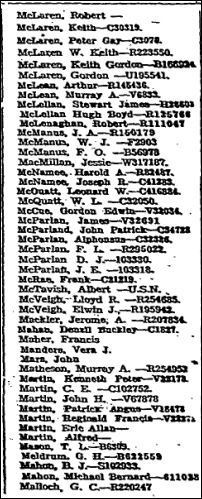
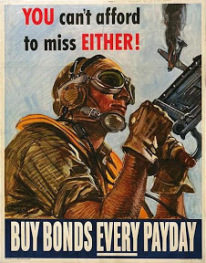

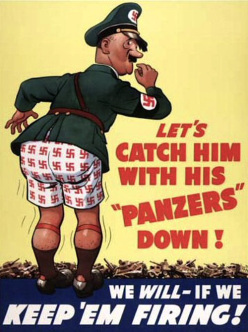
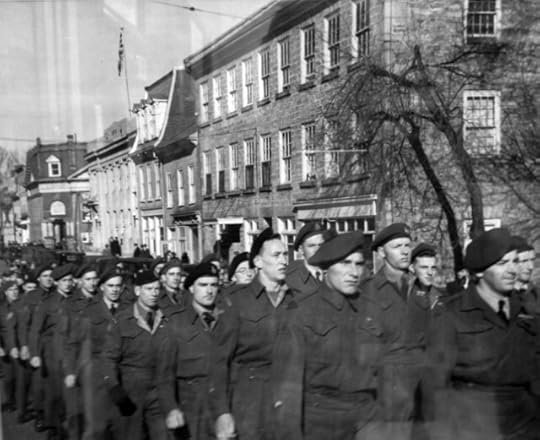
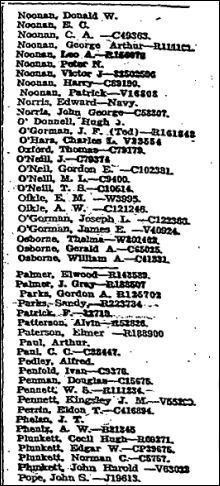

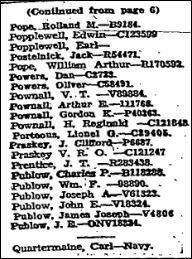

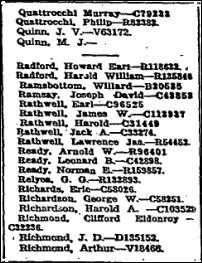

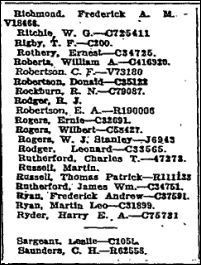
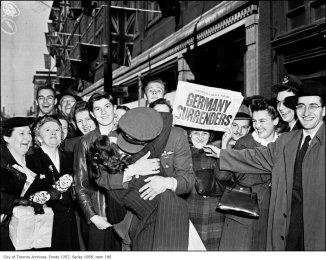
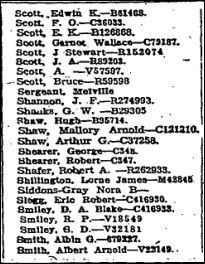
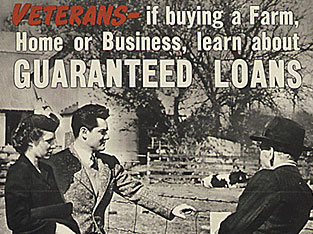
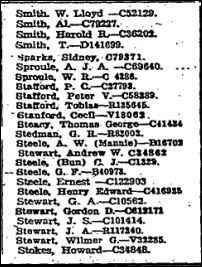
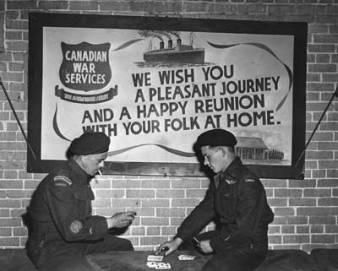
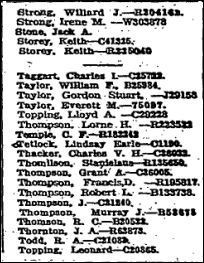
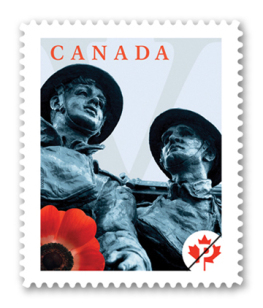
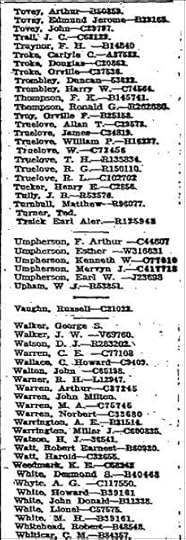

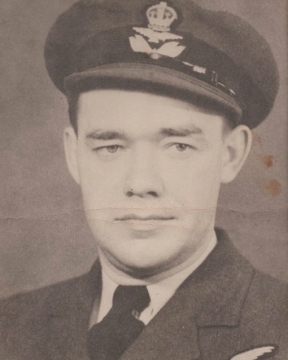
‘Perth Courier’ August 17, 1944
F.O. Robert White Now Presumed to Have Died“Mr. and Mrs. W. J. White, 15 Basin Street, have been advised by the Dept. of Defense, Ottawa, that their son, F.O. Robert White, who was reported missing after air operations over enemy territory on March 31, has now been presumed dead. A crew of seven manned the bomber which did not return and they are all presumed to have died. Shortly before he was reported missing on March 31, Bob was decorated with the D.C.M. at Buckingham Palace by the King.”
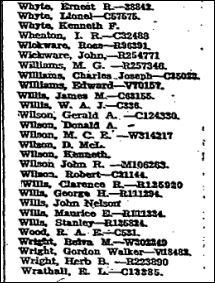
 Lanark and Renfrew Scottish Regiment “D” Company
Perth, Ontario, 1942
Lanark and Renfrew Scottish Regiment “D” Company
Perth, Ontario, 1942
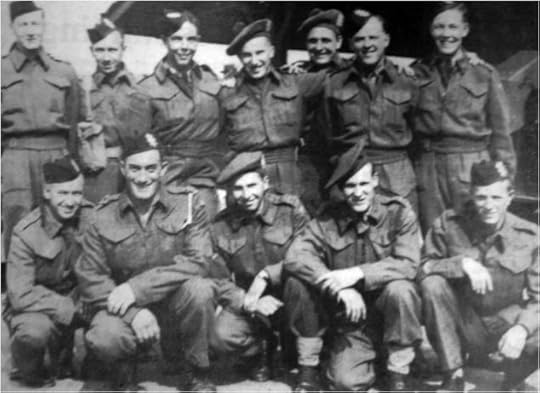
……………………………..
Missing from the Perth Courier’s list, but not forgotten:Burns, George
(submitted by Brenda Burns)Ferguson, Robert
Frizell, Ernest Darou, died 1943, buried overseas.
Goodson, Renfred ‘Bob’ Arthur
(submitted by Corinne Rivington)……………………………………………………………………
Hall, George Cecil
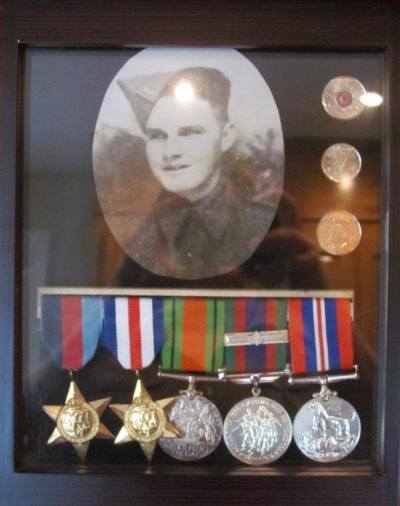
…………………………
Laroque, Kenneth Joseph
Lee, Joseph Patrick
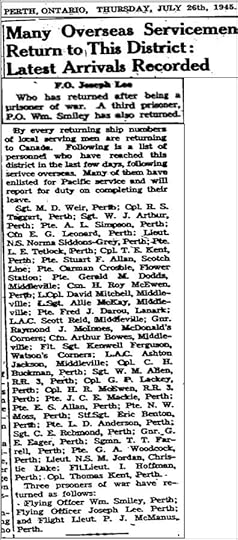
………………………………………………………
Rattray, Howard John
Rattray, Willard Arnold
Rattray, Clarence William
Rattray, John Elmer
…………………………………………………….
Weir, William Devlin
……………………………………………………..
Wood, Alva
Wood, Eldon ‘Pete’
Wood, Elva
(from Snow Road) – submitted by Trish Fournier……………………………………………………….
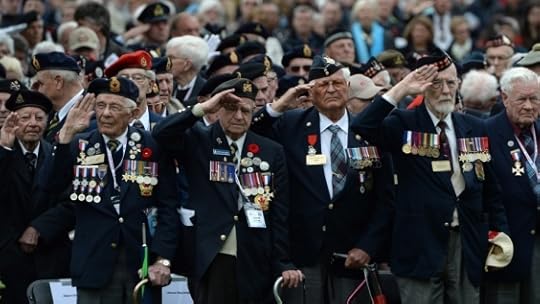
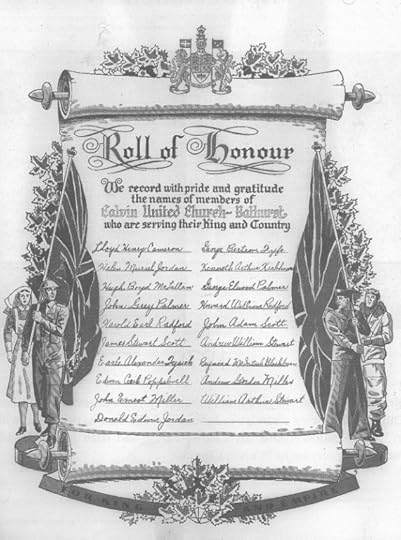
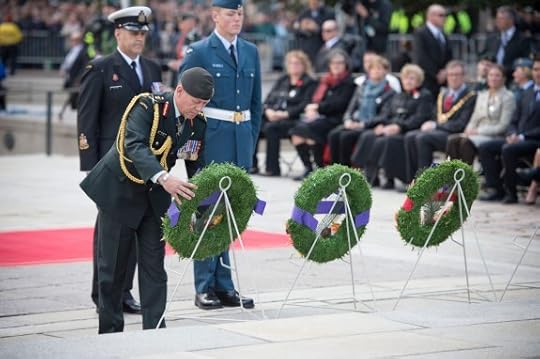


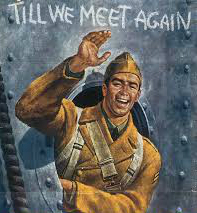
……………….
Local War Heroes: Kyle, McGlade, and DicolaFRIDAY, MAY 14, 2010
Article by ‘St. John’s School’, Perth, Ontario:
St. John’s School Playgroundto Be Dedicated to Local Fallen Heroes and Veterans“The St. John Playground Committee has chosen two local fallen Canadian Forces heroes and one local Veteran to be part of the dedication of their new playground.
The fundraising efforts for the new playground at the school taking place under the auspices of the Let Them Be Kids foundation dictates that any new playgrounds built are dedicated to a Canadian Forces fallen soldier or veteran from the area. After much reading and research by a Grade 6 class at the school, St. John’s has chosen Flying Officer William Kyle, Corporal James Michael McGlade, and veteran Corporal Francis DiCola to immortalize in the dedication of their new play structures.
Flying Officer William Kyle, born and raised in Perth, flew Dakota aircraft as a member of the RCAF 453 Transport Squadron based out of Tulihal, India. His squadron was responsible for moving freight and soldiers to and from various bases throughout the South Pacific. On June 21, 1945, a mission Kyle was on failed to return. The story of the missing aircraft came to prominence more than 50 years later, when the wreckage of the missing plane was discovered in the jungles of northwestern Myanmar (Burma), and Veterans Affairs Canada sought to uncover the wreckage and bring it home. Flying Officer Kyle’s watch, found at the scene, allowed Veterans Affairs to identify the crew and the plane.
Corporal James Michael McGlade, born in Perth and a graduate of St. John Separate School and PDCI High School, served the Canadian Forces as a member of the Royal Hamilton Light Infantry. Corporal McGlade signed up for the military in 1940 and was deployed overseas in 1942. Stationed in Antwerp, Belgium, Corporal McGlade’s regiment was responsible for the liberation, capture and preservation of the vital harbour and dock facilities at Antwerp. He was killed there in 1944 and is buried in Schoonselhof Cemetery in Belgium.
Corporal Francis E. DiCola, also a graduate of St. John Separate School and PDCI, enlisted in the Royal Canadian Air Force as a 17 year old in 1943. As a member of the RCAF Squadron 422 he was stationed at Pembroke Dock in Wales and worked as a radio operator. His job was to dispatch aircraft to various bases throughout Great Britain and the continent. While he was offered the opportunity to act as a guard during the Nuremberg Trials after the war, Corporal DiCola was anxious to return to Canada. He took advantage of the RCAF education packages offered to returning soldiers and took an economics degree at University of Toronto before returning to Perth to run the family business, DiCola Petroleum. Here he raised 7 children with his wife, Rose, and as a businessman and father, has contributed to countless endeavors in our community.
St. John’s is proud to dedicate their new play structures and schoolyard to these local Forces heroes. While the children are playing on the structures building their bodies and friendships, may they also be aware of these brave men who gave of themselves so that we could be free.”
…………………………………….
Be Sure to Visit the Perth Legion Hall of Remembrance:The Hall of Remembrance displays include artifacts donated by local veterans and their families such as war medals, letters, photographs, souvenirs, and display cabinets featuring army and navy memorabilia. The collection focuses on Perth and area’s contributions in World War I, World War II, Korea, Cold War, peacekeeping missions, and Afghanistan.
http://www.hallofremembrance.ca/exhibits/index.html
Hall of Remembrance – Royal Canadian Legion Branch 244, Perth-Upon-Tay – 26 Beckwith Street East Perth, ON K7H 1B5 Tel: 613-267-4400 (Office)………………………………………….
Library and Archives Canada Links for WWII Research:
………………………………………..
Search the Canadian Fallen Heroes Database:
Canadian Fallen Heroes Database
……………………………………………………………………………………………………………………………………………….
This tribute isin memory of all of the soldiers from the Perth areawho fought bravely for our country,so that we might live in peace and freedom.Lest We Forget………………………………………………………………………………………………………………………………………………………
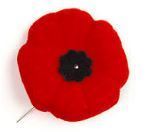
…………………………………………
November 6, 2021
Finding Our WWI Ancestors
Short days ago we lived,
felt dawn, saw sunset glow,
loved and were loved,
and now we lie in Flanders Fields.” — John McCrae
Over 600,000 men and women enlisted in the Canadian Expeditionary Force (CEF) during the First World War, (1914-1918) as soldiers, nurses and chaplains. The CEF database is an index to those service files, which are held by Library and Archives Canada.
This free online searchable database includes over 600,000 men and women who participated in WWI (1914-1918) including soldiers as well as nurses and clergy:
WWI Canadian Forces Personnel Records
These service files contain the name, address, service number, name of the next of kin, their physical description , skin colour, eye colour and scars or identifiable markings, and the unit number and location where they signed up for service.
On this site you can find links to the soldier’s file, which contain medical and pay records, and encompass a more detailed personal history of the soldier, and includes the specific units where they served, after going overseas. The soldier’s full service records are not available online, however, they may be ordered for a fee from Library and Archives Canada.
Also available are links to the Canadian Virtual War Memorial if the soldier died while in service.
War Diaries – This is a link to the diaries of the unit, not to personal diaries, but of the records of day to day life in a particular unit. This will give you great insight to how your ancestor lived in times of war in their group as they trekked across Europe and participated in various battles – some successful and some not.
Using the resources and links mentioned in this article, I was able to search and locate cousin Harry Stafford’s enlistment papers, his detailed medical files, including x-ray images and comments from attending physicians, his pay statements, physical description, and name and address of his next of kin.
I was also able to find out about the specific battle where he was wounded and subsequent hospitals in Europe where he received treatment. The records also state his date and condition at discharge, and pay records of any amount owing.
Harry’s story begins with the 130th Battalion, Lanark and Renfrew Scottish Regiment which was the ‘130th also known as the ‘overseas’ Battalion, based in Perth, Ontario.
They began recruiting in the fall of 1915, in Lanark and Renfrew Counties.
Harry’s StoryNine-year old Harry stood by the shore, and watched in horror as his eldest brother Wilfred struggled to the surface again and again, until he finally slipped out of sight into the deep blue waters of the Mississippi River near Lanark.
Harry and his brothers often played near the water, although none of them could swim. The four brothers stood on the shore that fateful day in July, and skipped stones on the surface of the water, just as they had so many times before.
Wilfred, two days shy of his thirteenth birthday, was the eldest of the four. He took great pride in showing his younger brothers how to pick the longest flattest stones. He coached them on how to hold the stones on their flat side, and throw them parallel to the water, so they would skip farther along the waves. Dick, at age ten, was beginning to get the hang of it. Harry and his twin brother Frank had turned nine two months before and were doing their best to keep up with the older boys.
Harry, the stronger and more athletic of the twins was trying to help his brother Frank as he struggled with the task. Frank had kyphosis which meant that he had a severe curvature of the spine. People in those days referred to Frank as a ‘hunchback’, but he was still able to do most things; although it might take him a little longer.
One of the boys had thrown his prized pocket-knife into the water by mistake, and Wilfred had gone into the water to retrieve it, slipped on a rock and fell into a deep hole, unable to swim, and drowned. The younger boys had raced back into Lanark to get help, but it was too late. By the time they had met up with the first grown-up it was already after five. Mr. Baker, the local tailor in Lanark hurried back to the spot, and pulled Wilfred’s lifeless body from the river.
Mr. Baker laid the body gently on the shore, and headed back to the Stafford home to deliver the news. Harry’s mother Mary (Murphy) Stafford was pregnant with her next child Carmel at that time, and both she and Harry’s father Peter were overcome with grief.
This would be Harry’s first, though not his last encounter with death at a young age. Two years later in the spring, his mother once again gave birth to twins – this time a boy and a girl – Rose Marie and Martin Wilfred, named for his late brother. The twins were born in the spring, and Harry’s parents were delighted to welcome the new babies into their growing family. Sadly, tragedy struck once again, and Harry’s new little brother Martin Wilfred, the weaker of the two passed away quietly, just seven weeks after his birth.
A few short years after the second tragic event in Harry’s family, war was declared in Europe. Canada was still under British rule at the time and as such would be expected to join in the war efforts overseas.
Within the next couple of years tales of the excitement and adventure on the front lines travelled back to Perth, and acts of heroism and valour were recounted in the local papers. Life on the farm, and the daily chores seemed mundane, compared with the glorified life of a soldier fighting for freedom.
The 130th Battalion, Lanark and Renfrew Scottish Regiment which was the ‘130th “Overseas” Battalion, CEF’ Based in Perth, Ontario, began recruiting in the fall of 1915 in Lanark and Renfrew Counties. When a recruitment officer arrived in the village of Lanark one winter, young Harry, just sixteen at the time lied about his age and signed up on the spot.
The Canadian Expeditionary Forces, as they were known, specifically recruited men between the ages of 18 and 45, so Harry claimed that he was born the same year as his brother Dick and was actually eighteen years old. They took him at his word, and Harry became an enlisted man on January 9th, 1916.
Harry, along with some local lads, was sent for basic training in Valcartier, Quebec and returned home for a brief visit before going overseas.
August 4 1916 – ‘The Perth Courier’“Corporals Ronald Scott, William Strang and Jack Scott (McDonald’s Corners) and Privates Lance Affleck, Ralph Craig, John Kingston, Harry Stafford, Henry Barrie (Watson’s Corners), and Joseph Bennett (Fallbrook) of the 130th Batt., Valcartier, are home on a week’s furlough – their farewell visit before going overseas.” (Harry was 17 by then)
The 130th Battalion left the Halifax harbour and sailed for Britain on 23 September 1916. After two weeks at sea, arriving in Liverpool, England on October 6th, Harry and the other members of the unit were absorbed by the ’12th Reserve Battalion, CEF. Their prime function was to provide reinforcements for the Canadian Corps that were already fighting in the field.
After fighting bravely in both England and France, Harry found himself participating in one of the most significant campaigns in WWI. Known as the Third Battle of Ypres (or Passchendaele) this battle was remembered both for its tremendous loss of life and casualties and because of the horrendous conditions of the battlefield.
The siege of Passchendaele went on for over three months from July through November 1917. More than 4,000 Canadians died and over 12,000 were wounded. The battlefield consisted of flat, swampy lowlands, and when heavy rainfall pounded the fields that autumn, the ground became a sea of mud. The men had to struggle through the thick mud with very little cover, while German soldiers tore them to pieces with their machine guns.
By November the Canadians were finally beginning to win the battle and began to push the Germans back from their stronghold. It was on the 6th day of November 1917 that 18 year old Harry was wounded in the leg by German gunfire at Passchendaele.
Harry was dragged out of the line of fire, received basic care from one of the medics to stop the bleeding and was sent to a hospital in England. He was admitted two days later on November 8th.
Word of Harry’s injuries was sent to his parents, back on the farm, in Lanark:” Mr. and Mrs. Peter Stafford received a telegraph from the Director of Records, Ottawa, on Friday, informing them that their son, Pte. Harry Stafford, 787104, had been wounded by gunshot in thigh and leg on Nov 6th, and admitted to No. 6 Field Ambulance Depot. Harry went overseas with the 130th Batt. in September, 1916, was transferred to another battalion for service in France, and has been through some severe engagements since crossing the channel. His many friends hope that Harry’s wounds are not serious.”
—-21 November, 1917, “The Lanark Era”The medical care during WWI was a very complex set of institutions, which cared for wounded soldiers from the battlefield, as soon after injury as possible. The soldier was evacuated as quickly as possible for treatment, and provided care.
The Field Ambulance was a mobile unit equipped with horse-drawn ambulances. They brought soldiers from the battlefields to an Advanced Dressing Station located at the rear of the siege out of harm’s way.
After Harry was shot, the first day he was sent to the #6 Field Ambulance Nov 6 1917, and after a month’s time was transferred to the Pavilion General Hospital Brighton Nov 23 1917, for three weeks.
Harry’s condition was not improving, and he suffered infection after infection. He was transferred to the Military Convalescent Hospital at Woodcote Park, Epsom, England on Dec 22, 1917 and he remained there receiving treatment for four and a half months.
In March 1918 he was transferred to Bramshott Military Hospital, where he was treated for one month, with still no sign of improvement.
It was during this time that Harry received word from his parents at home that his brother Carl had enlisted in a month earlier, and like Harry had lied about his age in order to join the service.
On July 8th, 1918 Harry was admitted to the Granville Canadian Special Hospital in Buxton, Derbyshire, England.
In November of 1918 WW1 finally ended. Losses of human life by Canadians and the allies were in the thousands.
After six months of unsuccessful treatment at the Granville Hospital in England Harry was finally discharged on December 3rd, 1918.
His condition continued to deteriorate, and on December 23 1918 Harry embarked for Canada sailing on the S.S. Tunisian.
Due to his medical condition, Harry was discharged from the military at Ottawa, on February 5, 1919.
Jan 10 1919 Perth Courier:“Pte. Harry Stafford, son of Mr. and Mrs. Peter Stafford, Lanark, returned home Monday from overseas. He went overseas with the 130th Batt. In November 1917 he was wounded in the leg and latterly has been receiving hospital treatment in England.”
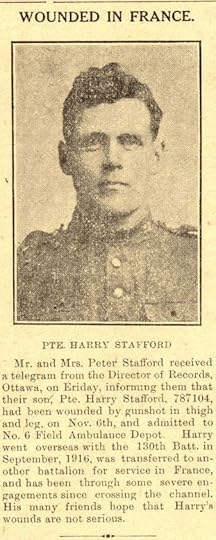
Harry’s condition never improved, and once again he was admitted to St. Luke’s Hospital in Ottawa on February 4th, 1920. He developed a cold two days after being admitted, and his operation was postponed until Feb 9th. Pneumonia developed 12 hours following operation, and Harry died two days later. There was speculation at the time that he may have contracted the flu while in the hospital, and that it turned to pneumonia in his already weakened state.
The influenza pandemic of 1917-1920 was a global disaster, and was actually responsible for killing more people than WWI. It has been said that it was the most devastating flu epidemic in recorded world history.
Because of the close quarters and huge troop movements during the war it is possible that these two factors hastened the pandemic and likely increased transmission of the virus. Many soldiers’ immune systems were weakened by lack of proper nutrition, the stresses of combat and chemical warfare, increasing their susceptibility to any illness.
Feb 20 1920 –“Died: In St. Luke’s Hospital, Ottawa on Thursday February 12th, Harry Alphonsus Stafford, son of Mr. and Mrs. Peter Stafford of Lanark, aged 20 years and 9 months.”Because he died at St. Luke’s Hospital in Ottawa, Harry’s death was registered in the County of Carleton, Division of Ottawa. His official cause of death was listed as pneumonia.
After a quick search on Ancestry.com, I found Harry’s death certificate:
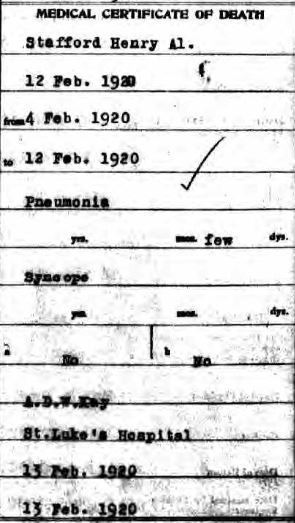
Harry is buried at the Sacred Heart Cemetery, Lanark, Ontario
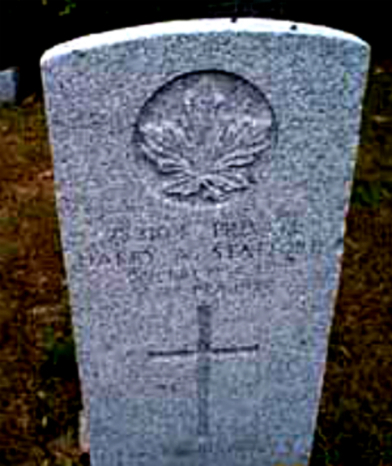
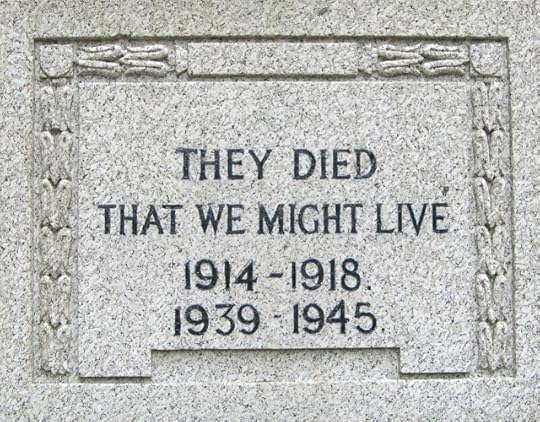
……………………

Are you researching a Canadian Soldier?
There are several resources listed below to help with your search.
……………………………………….
(the above is an excerpt from a book on the life and military service of Pte. Harry Stafford. The hard-cover book is available for research purposes at the Lanark Museum, 80 George Street, Lanark Ontario lanarkanddistrictmuseum@gmail.com, and at Archives Lanark, 1920 Concession 7 Road, Drummond Centre, Perth, Ontario adm.archiveslanark@bell.net)

 Lest We Forget
Lest We Forget………………………..
Link to: Canadian Soldiers of WWI
Link to Commonwealth War Graves
Link to Names in Book of Remembrance
…………………………
Tip:
Ancestry is offering a free trial up to November 24, 2021
Many military records are available.
November 5, 2021
Nevis Cottage
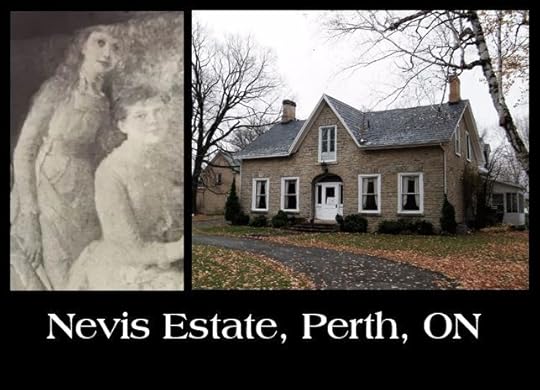
Nevis Cottage
I remember sitting in the back seat of the family car, going over the bumpy railroad tracks on Drummond Street, and asking Dad about the beautiful house, set back far from the road, in the beautiful garden setting. He said the home was called Nevis Cottage, named for the tallest mountain in Scotland, Ben Nevis. It seemed like an odd name for the place, and being a young child I couldn’t grasp why such a large property would be called a ‘cottage’, or why it wasn’t situated along the shores of a lake, like all of the other cottages I knew.
The home was built in 1840 by a respected Anglican minister, Reverend Michael Harris, who sold it to a prominent lawyer, Crown Attorney Donald Fraser. Perhaps the most well-known owners of this beautiful property were lumber baron, Peter McLaren, his wife, Sophia, and their children. The McLaren family purchased the property in 1870, along with an additional 400 acres of land beside the property.
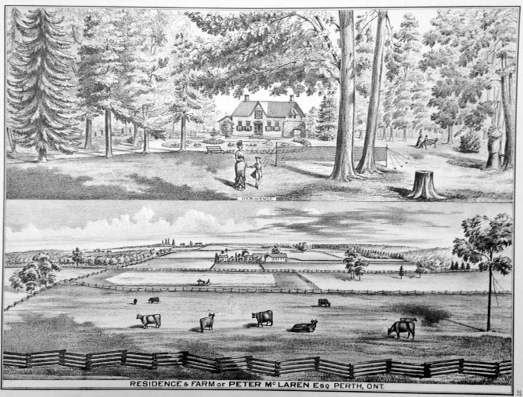
McLaren property, as it appeared in days gone by
Peter McLaren, son of James and Margaret Headrick McLaren, married, on November 22, 1867, at the age of 39, to the lovely Sophia Lees, age 22, daughter of William Lees and Mary Playfair.
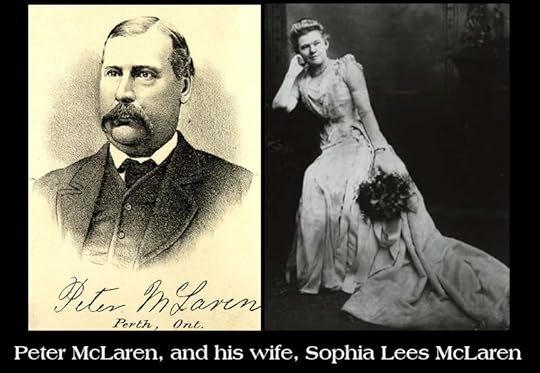
Peter McLaren doubled the size of the original dwelling to 7,700 square feet, extending the back of the original stone house. A large kitchen was added on the main floor, and several additional bedrooms, as well as servants’ quarters were added on the second floor. He also added a 4,700 square foot carriage house in 1880.

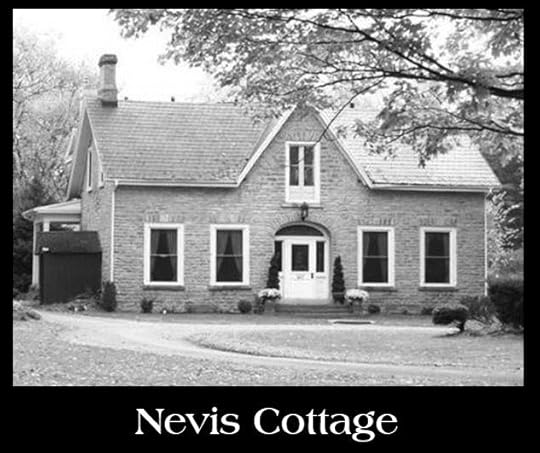
The five McLaren children:
Margaret Elsie McLaren Hall – 1869-1954
Married: November 18, 1903, to F. William Hall, M.P.P. for South Lanark, Barrister of Smiths Falls and oldest son of Francis Alexander Hall, and Harriett Frances Dunham Hall, of Perth. They lived for a while in the Perth area, and later moved to Oshawa. They had no children. Margaret died at age 85, in Oshawa.
Mary Isobel McLaren Benedict – 1874-1927
Married: at age 23, at St. James Anglican Church, Perth, June 22, 1897, to Charles Benedict, they moved to Toronto, where Charles worked at the Bank of Montreal. They had three children: Charles, born in 1900 and died as an infant, Doris Sophia, born in 1902, and Peter McLaren Benedict, born in 1907. Mary died at age 53 in Toronto.
Annie ‘Kathleen’ McLaren – 1875-1954
Kathleen chose to remain single, did not have any children, and was the last of the family members to reside at Nevis Cottage. When Kathleen passed away in 1954, age 79, she died without heirs. The McLaren estate, consisting of the grand house, the 600 surrounding acres, and all of the valuable artwork, jewelry, and fine furnishings, required the distinguished auction house of Ward-Price from Toronto, to appraise the family’s vast collection. Because she left no heirs, the estate of Kathleen McLaren caused a great deal of in-fighting, with claims to the estate and litigation that went on for many years after her death.
James Lyon Playfair McLaren 1878-1934
At age 27, James married Isabel Frances Geddes on February 14, 1906 at St. George’s church, Ottawa. Isabel was the daughter of Charles Geddes and Selina Sweetland. They had two children: Peter McLaren, born 1907, and Selina Sophia ‘Ena’ McLaren, born 1909. They moved to Springfield, New Hampshire. James passed away at the age of 57 at Springfield. The funeral was held at Nevis Cottage.
William Lees McLaren – 1880-1932
On October 14, 1910, at age 30, William ‘Willie’ McLaren married Anna Gemmill at her parents’ cottage on the Rideau Lakes. Her parents were Lawrence Gemmill and Elizabeth Kellock Gemmill. As a wedding gift, Senator (Peter) McLaren gave Willie and Anna a mining property on Otty Lake, known as Forest Lodge. They lived there and ran the mine. Willie passed away after an illness, at the Montreal hospital, at the age of 53. The funeral was held at Nevis Cottage. Willie and Anna had no children.
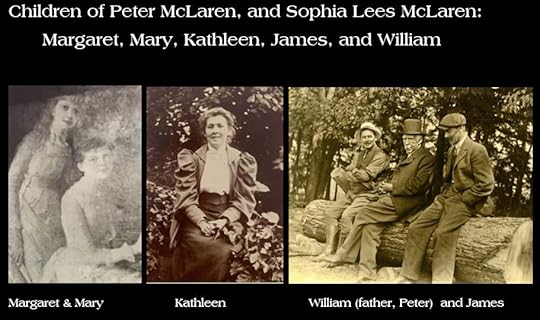
“William and James, were sent to a private boarding school
in Edinburgh, Scotland.”
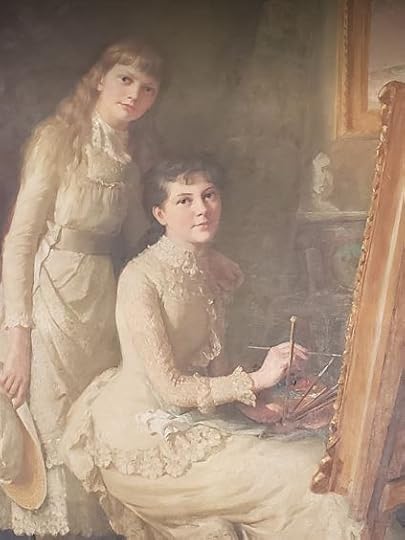
Peter McLaren commissioned artist John Wycliffe Lowes Forster (1850-1938) to paint his daughters, Margaret and Mary. The painting is currently housed at the Perth Museum. (Forster’s paintings are among those in the permanent collections of the National Gallery of Canada in Ottawa. Some of his memorable works include portraits of Sir Wilfred Laurier, Timothy Eaton, and Sir Sanford Fleming.)
1977 House Tour
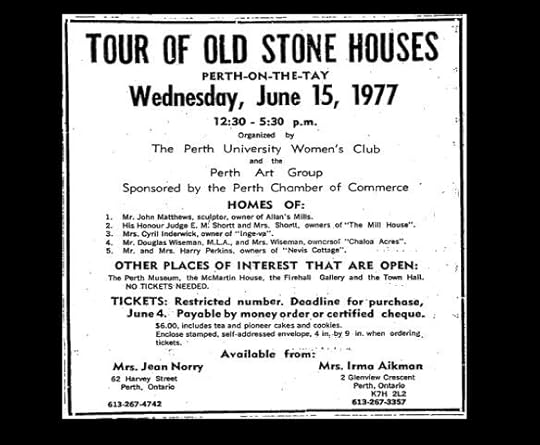
May 26, 1977, p. 12, “The Perth Courier”
In 1977, the Perth University Women’s Club organized a tour of Old Stone Houses, which included Nevis Cottage. At that time the property was owned by Mr. and Mrs. Harry Perkins.
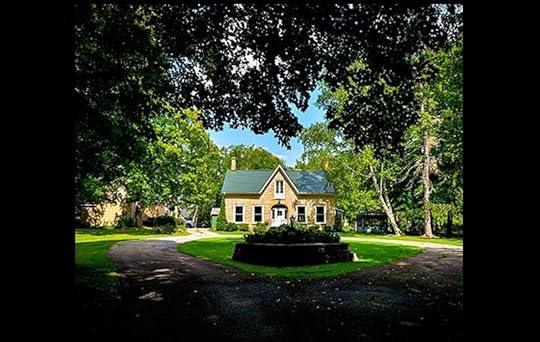
Modern view of Nevis Estate
Today, Nevis Estate is a bed and breakfast, located at 61 Drummond St. W., in Perth, Ontario.
In 2018, this video of Nevis Estate was featured on YouTube, and gives the viewer a glimpse at the lovely interior of the home, with all of its many entertaining spaces, and large, gracious bedrooms.
To view the video:
Although Nevis ‘Cottage’ looks very different today than it did when Senator Peter McLaren and his wife Sophie occupied the house remains a lovely property and will always be one of the notable homes in Perth’s long history.
Many years have passed since I first noticed the home, as I sat in the backseat of Dad’s old Buick, face pressed against the window, in the bumpy ride over the train tracks on Drummond St. I still love to hear the stories of the old days when the McLaren family lived there. In my mind I imagine the children – Margaret, Mary, Kathleen, James and Willie, running across the wide lawns, laughing and playing in their enormous yard. I can picture smartly-dressed servants carrying cool glasses of lemonade and biscuits to Mrs. McLaren and her friends, as she entertains them on the back lawn.
As the pink sun sinks low in the sky and the day draws to a close at Nevis Cottage, we can picture Senator Peter McLaren arriving home after a long day overseeing his lumber business. He hands his cane and hat to the house maid as he enters, and greets Sophia and the children warmly, as they prepare to sit down to a sumptuous meal, in their elegant home. Another perfect evening at Nevis Cottage.

Notes:
(In 1983, a magazine called,”Canada Century Homes”, featured Nevis Cottage, as well as The Crain House, The Mill House, Inge-Va, and Matheson House)
(photo of the painting of the McLaren girls, courtesy of the Perth Museum)
Vincent Lally-Perth Journalist
Memorable People
of Lanark County
Vince Lally, Perth native, had a remarkable career as a well-respected journalist.
For over 65 years in all, he shared the news of Perth and district,
including 35 years as a correspondent, to “The Ottawa Citizen, “The Kingston Whig Standard”,
“The Toronto Telegram”, and “The Globe and Mail”.



An article from “The Perth Courier”, published in fall of 1971,
one week after the death of local journalist, Vince Lally:

news article from “The Perth Courier”, Nov. 4, 1971, p. 2 – part two of article below
“Born in 1889, Vince was one of the last “Old-timers’ in Perth.”


Typesetting by hand
Article continues…
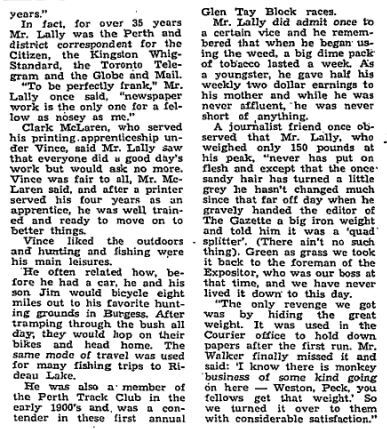
(conclusion of the news article from “The Perth Courier”, Nov. 4, 1971, p. 2)
In 1916, Vince, age 26, married Margaret ‘Maggie’ Bennett, in Perth.
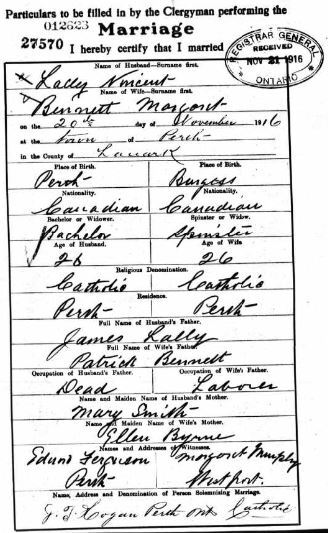
Ontario, Canada, Marriages, 1826-1938
Vince (1889-1971), and his wife, Maggie Bennett Lally (1890-1985) , had two children – James Joseph ‘Jim’ Lally, (1918-1995), and Nora Lally Haughian (1921-2008). Jim, a Journalist, followed his father into the newspaper business, and Nora had a 29-year career with Ontario Hydro.
The Lally home

Vince Lally and his family lived at 53 Harvey Street, Perth, ON (photo: google maps)
Vince passed away, at the age of 82, in 1971,
a few months after his retirement.

St. John’s Cemetery, Perth, Ontario
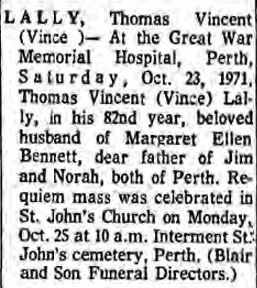
Ottawa Journal October 23, 1971, p.31

After his lengthy career in the newspaper business, Vince Lally will be remembered as the longest serving journalist at “The Perth Courier”, with a work history spanning 65 years.


November 4, 2021
Elmcroft Mansion, Smiths Falls
Elmcroft was built in 1895, by Senator Francis Theodore Frost, President of the Frost & Wood company, manufacturers of farm implements. His father, Ebenezer Frost, founder of the company, settled in Smiths Falls in 1839 and opened a shop known as the Agricultural and Implement Works. Later, they began manufacturing stoves and plows, and grew into one of the most successful agricultural manufacturing companies in Canada.

Elmcroft – photo: William James Topley – family photo album – taken between 1890-1910
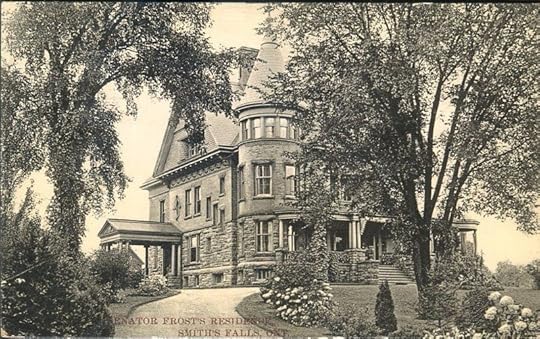
Elmcroft, 1907, photo: private family collection

The beautiful Maria Powell Frost, wife of Senator Frost, – photo: taken in Ottawa, 1873
Maria Eliza Powell Frost was born in Madrid, St. Lawrence County, New York, married Francis Theodore Frost on June 3rd, 1868.

Photo: Maria Frost in her later years. Maria was known for her service to the church and her support for local charities. For many years she taught the primary class of the Sunday School at St. Paul’s Presbyterian Church. She was elected to the National Council of Women of Canada and held that position for many years. She also represented the Smiths Falls Chapter at the Quinquennial Congress of the International Council of Women held in Toronto, Ontario, in 1909.
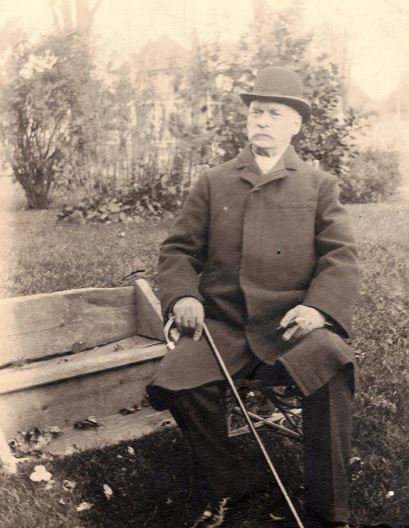
1915 Senator Frost sitting at Elmcroft Mansion, photo: JJ Kerfoot family album

Executives of Frost & Wood on the lawn in front of Senator Francis Frost’s home “Elmcroft”. Charles Frost, President, is seated on the far left. c. 1907
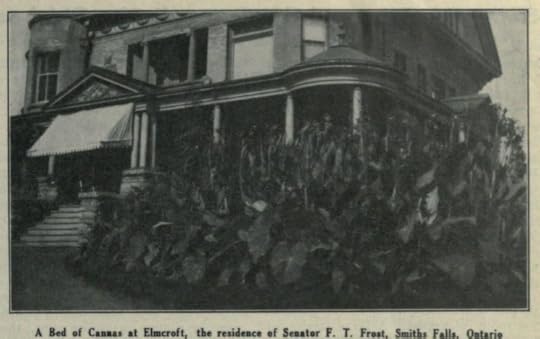
Elmcroft, featured in the March, 1911 edition of The Canadian Horticulturalist, highlighting its 27 ft x 15 ft Canna flower beds
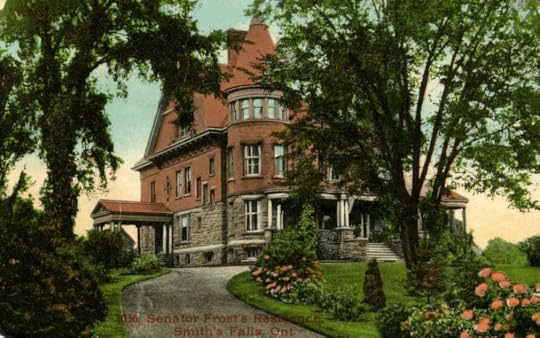 Elmcroft – Senator Frost’s Home, Smiths Falls, Ontario
Elmcroft – Senator Frost’s Home, Smiths Falls, OntarioIn 1901, Senator Francis Frost, 57, and his wife Maria, 54, lived at Elmcroft, along with Maria’s mother, Mary Powell, 84, and their two servants, Elizabeth Nolan and Mary Dillon, both age 28.

Sir Wilfred Laurier, the Prime Minister who appointed Francis T. Frost to the Senate, visited Elmcroft to enjoy tea with the Frost family
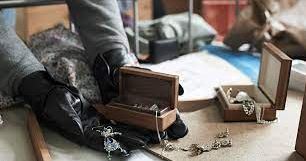
In July of 1907 a jewel thief entered Elmcroft and stole all of the Frost family’s opulent jewelry. The value of the jewels was so significant that the story of the burglary was featured in the Toronto Globe newspaper.
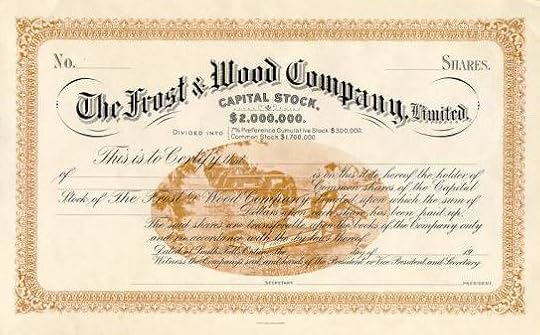
A share certificate from the Frost & Wood Company

The Frost & Wood company as it appeared in 1924
ELMCROFT TODAY
Elmcroft B & B
In 2008 Ken and Cathy Thom purchased the home known as Elmcroft, at 89 Chambers St., for $200,000. and after two years of extensive renovations, they opened the Elmcroft B & B in April of 2010.

photo: Tonia Kelly, Smiths Falls This Week, Metroland Media, March 31, 2011

The Smiths Falls Municipal Heritage Committee recommends that four mansions — all located on Chambers Street East — be designated as “Heritage Properties of Interest.”
The Frost Mansion Row includes:
Charles B. Frost Mansion
57 Chambers St. E.

Charles Beriah Frost, Vice-President of Frost & Wood Co.- (1840-1909)
(the property at 57 Chambers St. is already designated a Heritage Property of Interest)
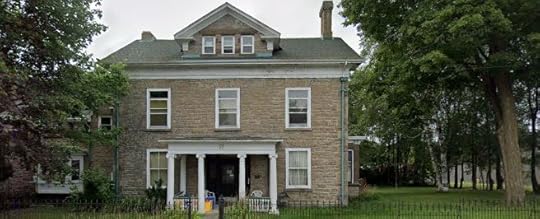
57 Chambers St. E.
The grand house at 57 Chambers St. E. was originally built for Abel Russell Ward who is considered the founder of Smiths Falls. His house was the largest and finest in the village at the time it was built. Abel Russell Ward owned the property until 1881 when it was sold to Charles B. Frost, and it remained in the Frost family for many years. It was designated a Heritage Property in 1983.
Edwin Frost Mansion
65 Chambers St. E.

65 Chambers St. E. – built in 1905 for Senator Frost’s brother, Edwin, currently owned by Joseph Murray
McKimm Mansion
69 Chambers St. E.
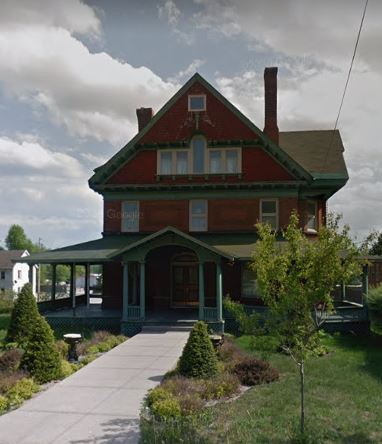
69 Chambers St. E. was built in 1905, home of George F. McKimm. McKimm married Helen Elvira Frost, and was Founder and Editor of “The Rideau Record”. The local newspaper, founded in 1887, played an important role in local politics, and later became
“The Record News”. McKimm played a pivotal role in securing funding from philanthropist, Andrew Carnegie, in 1902, to build the Smiths Falls Public Library. The house is currently owned by the Douglas and McEwen families.
Senator Frost’s Mansion
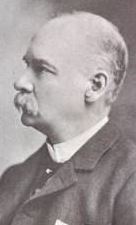
Senator Francis ‘Frank’ Theodore Frost (1843-1916)
89 Chambers St. E.
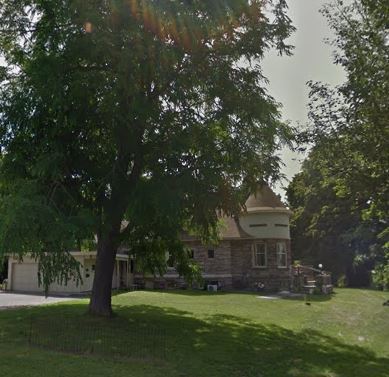
89 Chambers St. E.
Elmcroft Mansion Timeline
Senator Frost’s Mansion was originally built in 1895 as a three-storey mansion in the Queen Anne revival style. Senator Francis T. Frost, the son of the founder Ebenezer Frost, and later President of Frost and Wood, a farm equipment company operating in Smiths Falls for 116 years. Frost was the first mayor of Smiths Falls, became the MP for North Leeds and Grenville and in 1903 was appointed to the Senate during the Laurier government.
The grand home once boasted two halls, a dining room, two staircases, a library, and stables. It was said that the home was so massive, that a freight car load of coal was needed every winter to heat the building.
After the death in of Senator Frost in 1916, his wife, Maria, inhabited the house for roughly 10 years, until she left. The house stood vacant until 1938, when the Founder of Rideau Beverages, a bottler for the Coca Cola Company, J. Clark Ketchum, bought Elmcroft. Because of extensive water damage, Ketchum removed the top floor of the home and added a garage, however, the house still retains many of its original stately ground floor features. At one time, the building housed Dr. Penny’s medical practice.
Groundskeeper’s House
97 Chambers St. E.
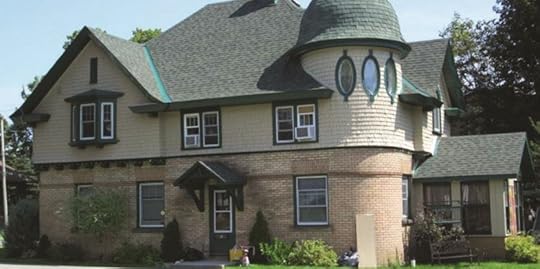
97 Chambers St. E., Smiths Falls –
The Carriage House located at 97 Chambers St. E is considered a significant heritage property because of its connection with its adjacent property, Elmcroft. It was the residence and workshop of Senator Frost’s full-time groundskeeper.
Mansion Row Map
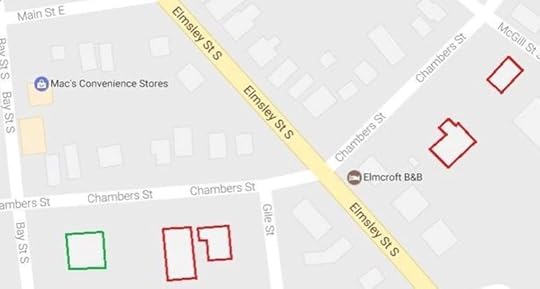
The homes of ‘Mansion Row’, Chambers St. , Smiths Falls, ON
These stately homes were all originally built and owned by immediate descendants of the Frost family, the founders of the Frost and Wood Company.
If you’re visiting Smiths Falls, be sure to drive along Chambers Street E. and enjoy the beauty of these historic mansions.
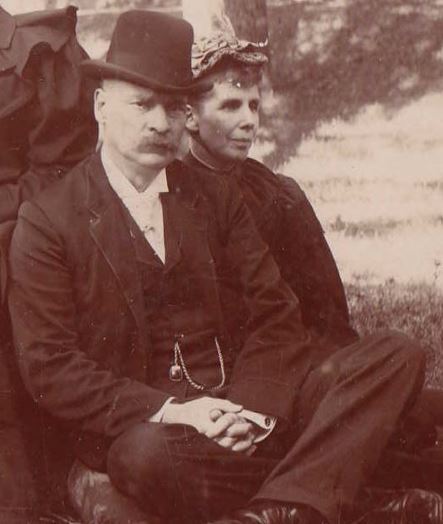
Senator and Mrs. Maria Eliza Frost relaxing on the grounds at Elmcroft
November 3, 2021
Lanark County Teachers 1896
Who were they? Who were the men and women who taught at Lanark County’s one-room school-houses in 1896? These schools had no running water, most had outhouses, and it was the teacher’s job to make sure that the wood stove kept burning throughout the day. Travelling by horse and buggy in the heat of summer and through winter storms, they braved it all to be there in the classroom, teaching our ancestors…

Bathurst Township
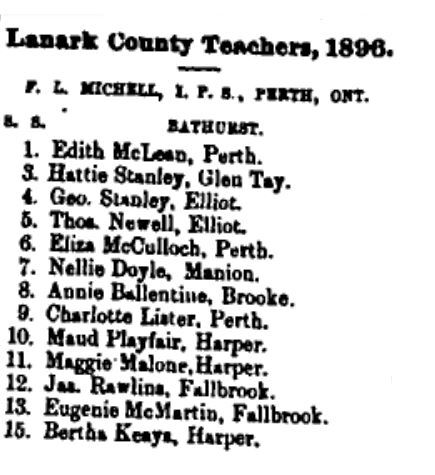
Beckwith Township
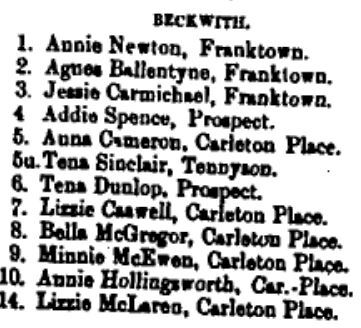
North Burgess

Dalhousie Township
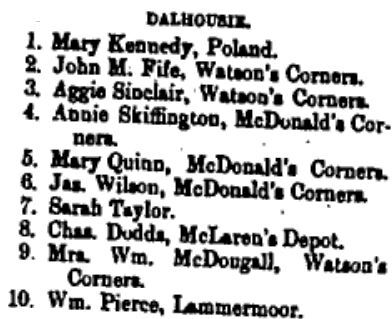
Darling Township
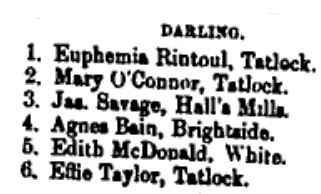
Drummond Township
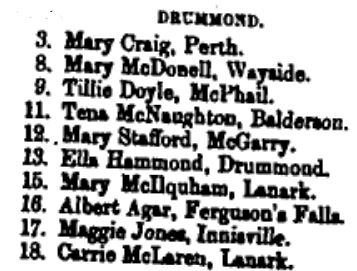
Elmsley North
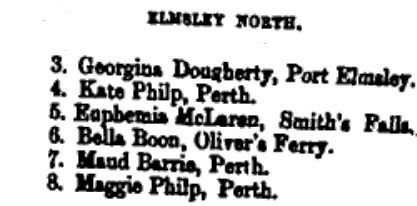
Lanark Township
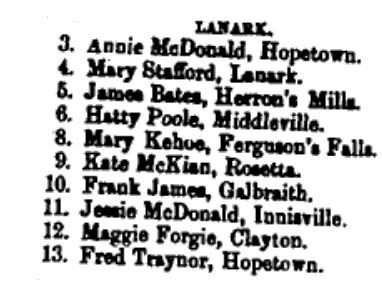
Lavant Township
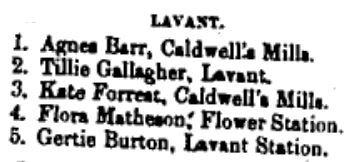
Montague Township
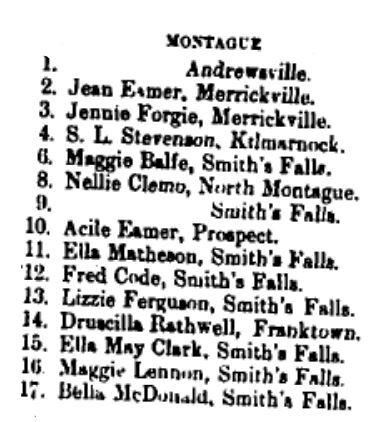
Pakenham

Ramsay Township
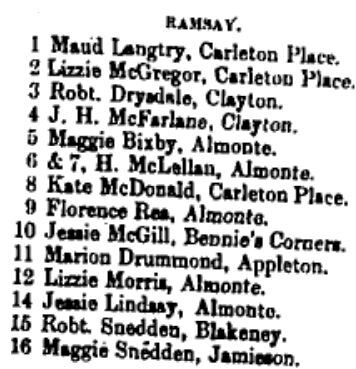
South Sherbrooke
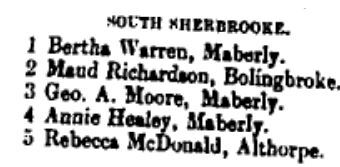
North Sherbrooke

Lanark County
Before & After
Amalgamation:

Maps of Lanark County – from Ontario Genweb (Rootsweb)
Thank-you to all those who taught our ancestors
in Lanark County’s one-room schools.

November 2, 2021
History of Tayview
The opening of the House of Industry, later known as Tayview Nursing Home, then Perth Community Care Centre, was held at the site, just outside of Perth, on January 30, 1903.
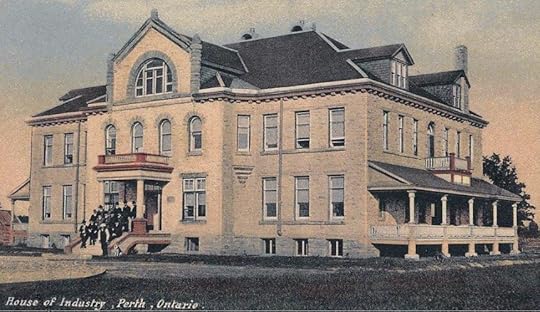
Cost to Build:
From a report published in “The Perth Courier”:

Opening Ceremonies
& Entertainment
Speeches were made by visiting dignitaries, and tours of the new building were attended by many from the community and surrounding area.
“The programme committee had planned out a good list of diverse amusements. It was their desire to meet all demands. Music was provided and good music at that, for those who have a musicianly vein in them.”
“A smoking-room was given over to the men who had an enjoyable pull at the brier, and at the same time were entertained to gramophone selections.” Mr. Everard Doyle was in charge of the tobacco and cigar counter.”
“Two ping-pong tables were located in the confectionery room over which Mrs. Foy presided, while in the attic was a shooting gallery in the keep of Mr. George King. In the evening the large crowd was treated to some popular singing by a chorus of male voices, led by Mr. Chris Forbes, of Lanark.”
Reverend A.H. Scott delivered the dedication of the House of Industry, which included:
“Wilberforce, when he had reached the Indian summer period of his life remarked: I can scarcely understand why my life is spared so long except it be to show that a man can be as happy without a fortune as with one.”
Rev. Scott continued, “With the blessing of the Lord and the practical kindness of this community those who are to be occupants of this institution shall have reason to confirm the declaration of David:
“I have been young, and now am old, yet have I not seen the righteous forsaken, nor his seed begging bread.”
Members of Lanark County Council
representing their constituents
at the Grand Opening:
Warden : Walter G. Cameron

Lanark County Councillors 1903-1904:
W.H. William Stafford, K.C., Almonte barrister, representing Galbraith
A.F. Shearn, representing Galbraith
Wm. Campbell representing Montague
J.S. Livingstone, representing Montague
Wm. Pattie – representing Mississippi
Joseph C. Cram – representing Mississippi
Wm. Watters – representing Tay
Robert Smith – representing Tay
J.M. Rogers – representing Perth
Robert Laidley, representing Western
John Forsyth – representing Highland
John MacLean – representing Highland
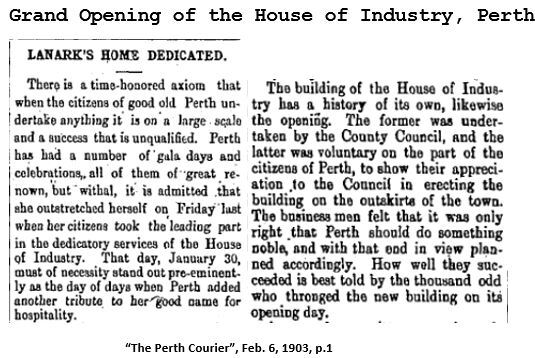
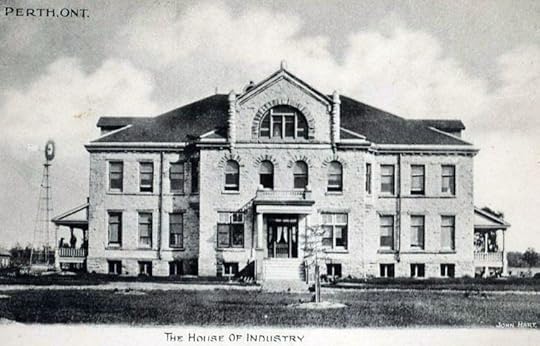
The House of Industry, 1911
First known as “The House of Industry”, then as “Lanark County Home”, then “Tayview Home”, and now Perth Community Care Centre
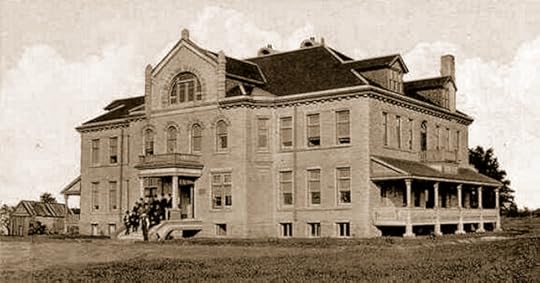
Name Changed 1940
to Lanark County Home
In 1940, the name of the institution was changed from “The House of Industry to “Lanark County Home”
In 1958, the home was presented with a brand new television set, from the Lionettes
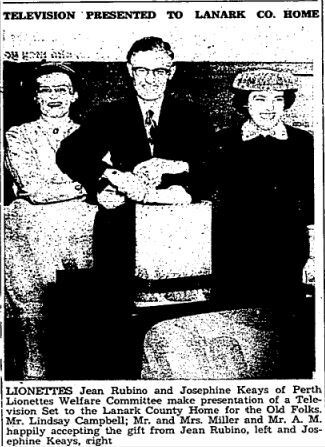
An ad for a nurse was published in “The Perth Courier” on September 10, 1958, p. 7:

“The Perth Courier” Sept. 10, 1959, p. 7
Name Changed 1959
to Tayview Home
In December of 1959, council recommended a name change to Tayview:
“The Perth Courier”, December 24, 1959, p.5
Name Changed to
Perth Community Care Centre
Life at the Perth Community Care Centre
Featured in 1980s News Column
In the 1980s, “The Perth Courier” began to publish a column outlining the recent activities of the residents of the Perth Community Care Centre, as it was know. Residents birthdays were listed, as well as a ‘Resident of the Month’
Oct. 1981
Surnames: BARTRAW, CHURCH, CLARKE, CLOSS, MACMILLAN, REED, RITCHIE, WHITE
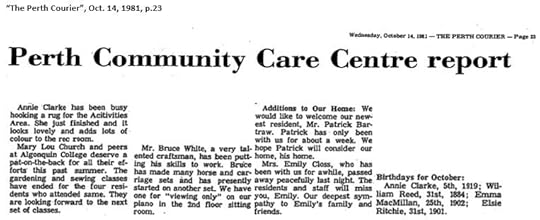

Nov. 1981
Surnames: CHARLTON, CONBOY, CUMMINGS, DODDS, FINNERTY, LALONDE, MCTAVISH, MURRAY, PERDUE, PITURA, RICHMERE, ROBERTSON, TROMBLEY,
Resident of the month: Nettie Charlton Dodd
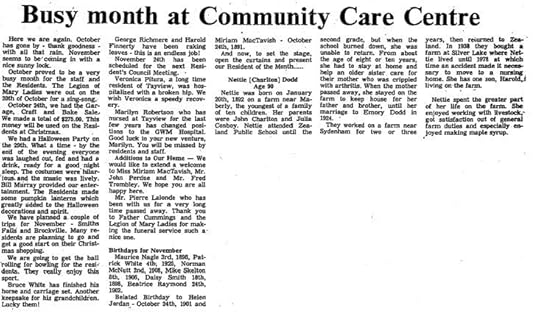
December 1981
Surnames: ARCHAMBEAULT, BISSONETTE, BRODERICK, COOPER, CRAIG, CYBACK, DOWSETT, KANE, KEEPING, MACKLER, MCSHANE, MORRISETTE, MULHOLLAND, NAGLE, SEABROOKE.
Resident of the month:
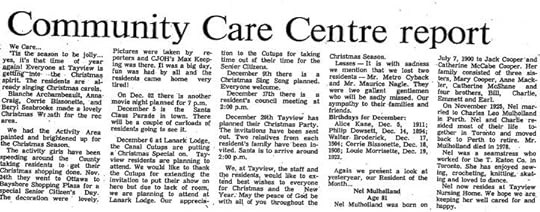

With autumn decorations

Perth Community Care Centre, in modern times, with additions built to accommodate more residents
Established in 1903, the Perth Community Care Centre continues its long tradition of serving and housing seniors and those requiring assisted living. With accommodation for 120 residents, this historic facility is located at 101, Christie Lake Road, Perth, Ontario.

November 1, 2021
November -All Saints & All Souls
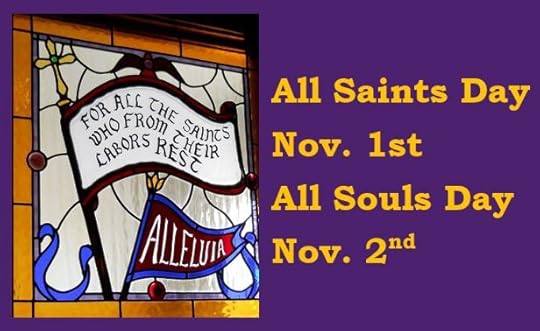
Nov. 1st – All Saints Day
Every year on November 1, many Christians around the world observe All Saints Day, to honour all of the saints who have reached heaven.
In the British Isles they began to celebrate All Saints Day on November 1st, hundreds of years ago, as early as the eighth century, to coincide with the Celtic festival known in Ireland and Scotland as Samhain. It is believed that November 1st was chosen because Samhain (October 31st, Hallowe’en) was the date of the Celtic festival of the dead.
All Saints Day is not only to remember Saints, but all those who have died who were members of the local church congregation. In some congregations, a candle is lit and each person’s name is called out by the minister or priest. In some churches the names of those who have died in the past year are etched on a memorial plaque, or listed on a church memorial bulletin.
Nov. 2nd – All Souls Day
On Nov 2nd, known as ‘All Souls Day’, the Irish believed that the souls of the dead would return to their families and speak to their descendants, passing down two gifts:
The ability to recall the olden days and traditionsThe ability to have a deeper understanding of the links to their bloodlines.
Sweep the Floor!
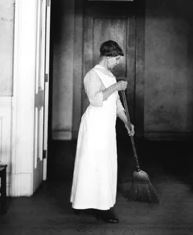
Light the Fire!

In preparation for the return of the dead, Irish families would sweep their floors, and light a strong fire. A bowl of spring water was placed on the table, and a place setting was laid out for each deceased family member.
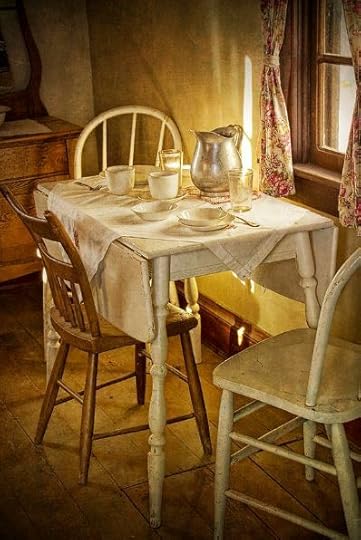
Soul-Caking

In some parts of Ireland the young children would go “soul-caking,”. They knocked on their neighbor’s doors, and asked for cakes in exchange for prayers to be recited for the dead.
Soul Cakes are a cross between a scone and a biscuit, and are easy to make. The little cakes are marked with a cross before being baked.
Soul Cake Recipe
butter ¾ csugar ¾ c3 egg yolks2 c white flour2 teaspoons allspice or cinnamon½ c currants or raisinsa little milk to mix (2 Tbps)Cream the butter and sugar together and then add beaten egg yolks Add flour and spice, then mix with butter, sugar and egg yolk mixture.Stir in the currants and add enough milk to make a soft dough, similar to scones.Roll dough, cut out little cakes with a biscuit cutter. Mark each cake with a cross and place them on a greased baking sheet.Bake the cakes for 10 to 15 minutes, at 375,or until golden brown.Cool on a wire rack and the store in an airtight tin for up to 5 days.Candles at the Grave
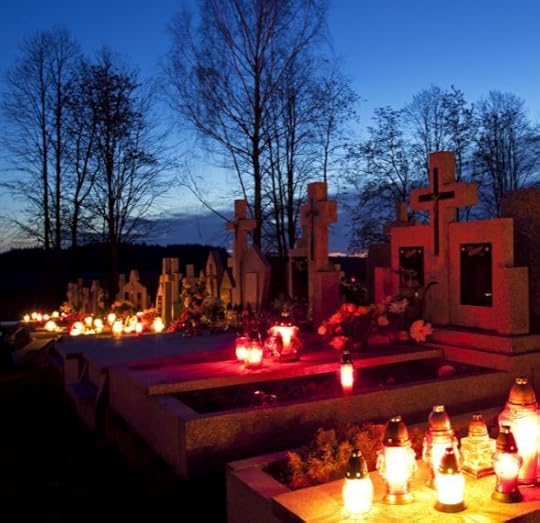
The Irish would also visit the graves of deceased family members, clean the graves and the area around them, light a candle, and leave it burning alongside the tombstone.
Blessings
The traditions and customs of All Saints Day and All Souls Day continue today, passed down through the generations, and on through the next generations.
“Soul, Soul, a soul cake!
I pray thee, good missus, a soul cake!
One for Peter, two for Paul,
three for Him who made us all!
Soul Cake, soul cake, please good missus, a soul cake.
An apple, a pear, a plum, or a cherry, any good thing to make us all merry.
One for Peter, two for Paul, & three for Him who made us all.”
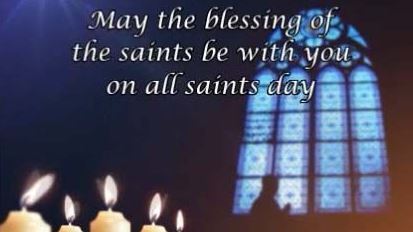
October 29, 2021
Hallowe’en in Perth – 1960s and 1970s
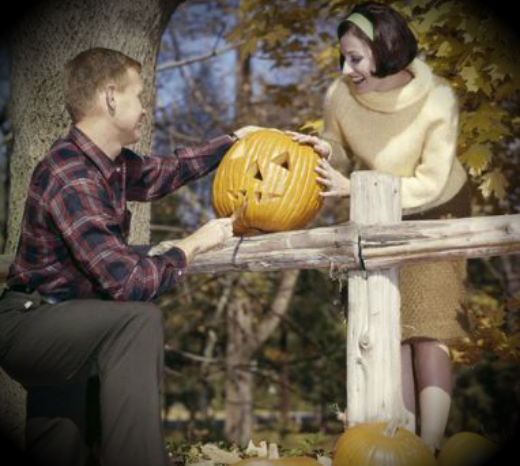
Oh the tricks and treats in the town of Perth, in the 60s, and 70s!
Come along for a trip down memory lane, as we re-visit the spooky Hallowe’en nights – the candy, the costumes, the dances, and some naughty behavior thrown in for good measure!
The TreatsYou might be surprised to find out the kinds of treats we had in the 60s and 70s. One of the most popular treats – Apples! Apples were an economical treat, especially for people who grew them in their own back yards, and it was not uncommon to have seven or eight apples in our sacks by the time we returned home from our trick-or-treating.

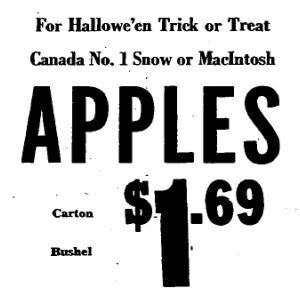
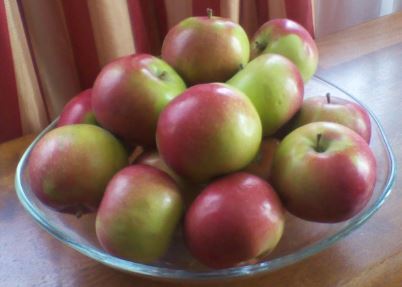
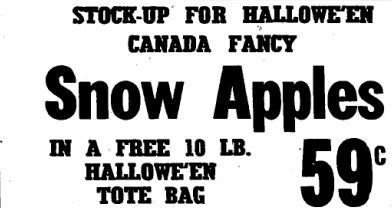
Two of the most popular treats back in the 60s and 70s, were peanuts in the shell, and Hallowe’en ‘kisses’. Loose peanuts were an affordable treat to purchase, and often, the people who answered the door would grab a handful from a big bowl, and drop them into our sacks. Same with the Hallowe’en kisses. They were usually given out loose, by the bunch, and weren’t as expensive as some of the other treats available for sale at local stores.
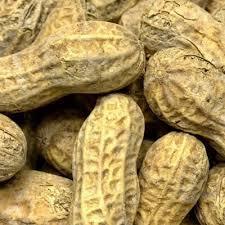
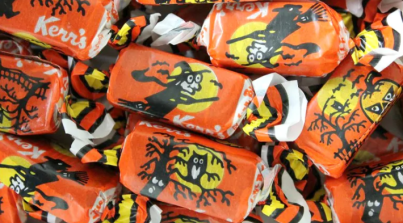

In 1961 – Decorated sugar cookies, wrapped brownies, cupcakes – anything homemade, were considered crowd-pleasing treats!
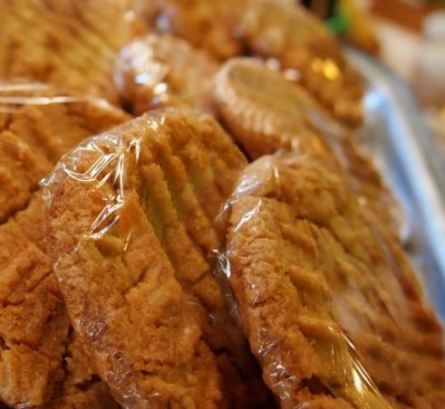
You might see a plate of cookies like these, wrapped individually, in saran, at a neighbour’s home, ready for trick-or-treaters!
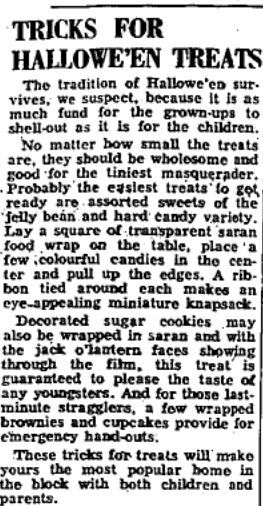
These were very popular in the 1960s, and it was almost certain that you would get a couple of these candies during a night of Trick-or-Treating – everyone’s favourite – Bazooka Joe bubble gum, with the comic inside, or sour Rockets.
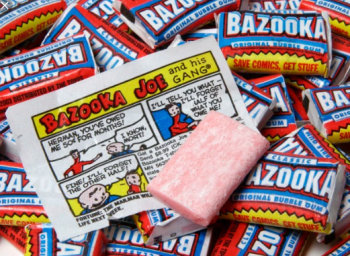

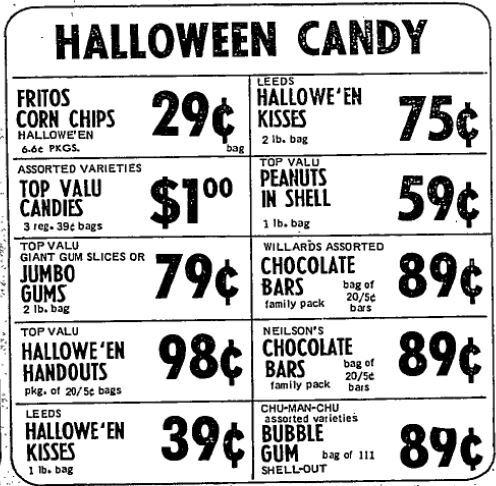
Hallowe’en Decorations
In the 60s and 70s, we had two main Hallowe’en decorations that you might see at someone’s house – the jack-o-lantern, and the outdoor light.

The Jack-o-lantern was usually carved the night of Hallowe’en, and consisted of three triangles – two for the eyes, one for the nose, and a mis-shapen mouth, that was usually a bit crooked. We didn’t have ‘pumpkin carving kits’, or ‘stencils’, or ‘patterns’. The example above, is likely what you might see on someone’s front step, or porch.
The second most common Hallowe’en ‘decoration’ of the ’60s and ’70s was the Outdoor Light. This was the single most important indicator of whether we would be trick or treating at a particular home, or not. If the light was out, that meant that the home-owners had either gone to bed, or had run out of candy, so that was our clue not to bother knocking. If, on the other hand, the outside light was on, then we made a bee-line straight for the house, knowing that someone was willing to drop a candy or two into our sacks.
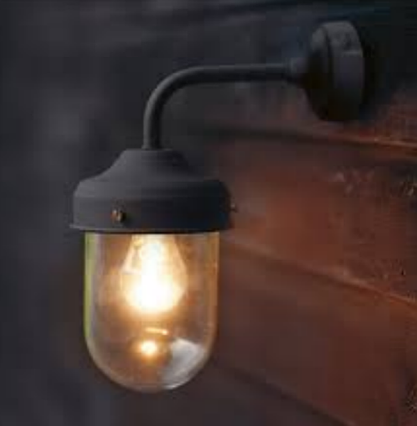
Today, we see very elaborate decorations, strings of lights, fancy candles, strobe lights, spooky music, and more. Kids would be surprised that we did not have any of that.
It was very unusual to see anything other than a Jack-o-Lantern, on Hallowe’en. Many people even thought it was wasteful to buy a pumpkin, carve it up, and throw it out the next day. Not everyone was affluent enough to do this. It was more common to see the ‘Outdoor Light’, and be satisfied with that. How times have changed!
Hallowe’en Dances and Masquerade BallsMany of the local halls and clubs held special Hallowe’en dances or masquerade parties. Some of the most popular venues of those times for dances, where people dressed in costumes were, the Maberly Agricultural Hall, the ABC Hall in Bolingbroke, the Legion, the Lions’ Hall, and the Ompah Community Hall.
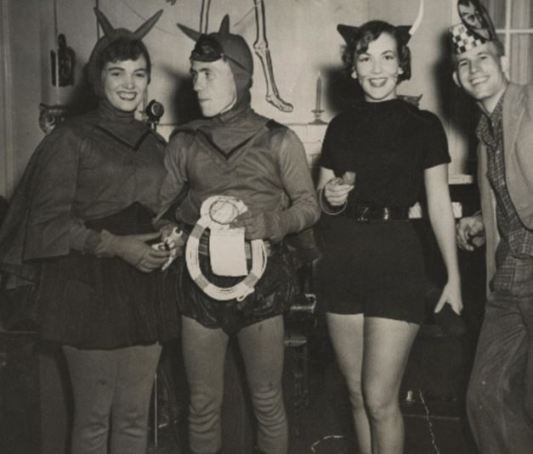
You could strut your stuff at the Maberly Agricultural Hall…
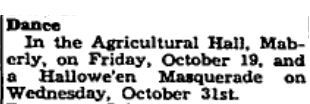
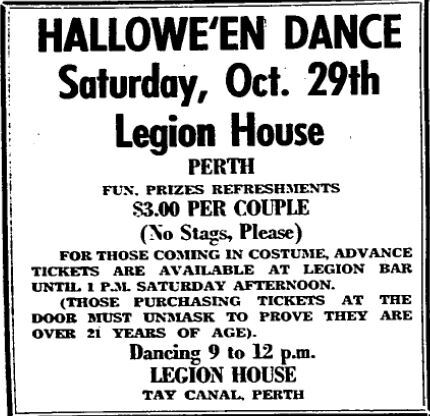
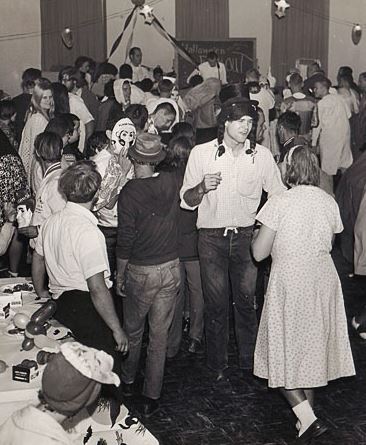
Or dance the night away in Bolingbroke, at the ABC Hall…
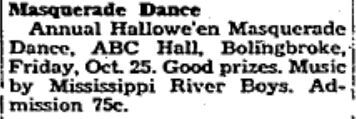
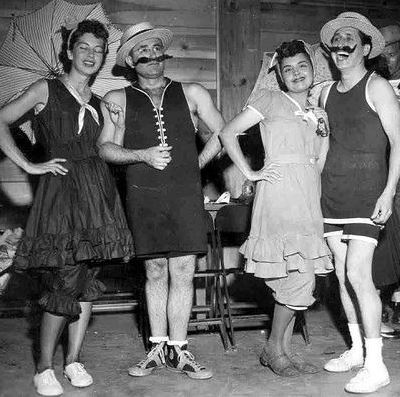

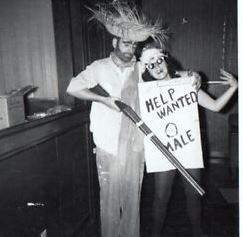
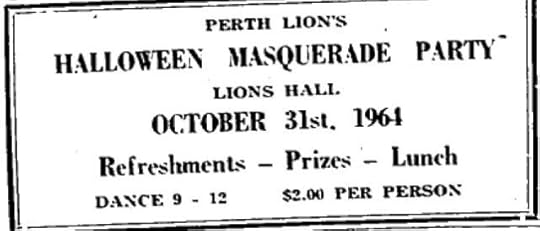
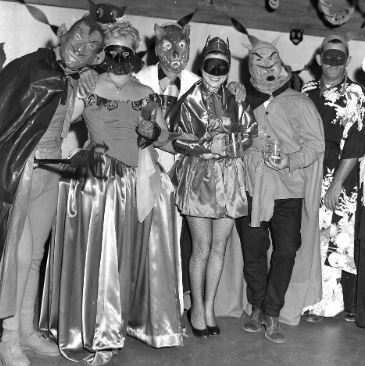
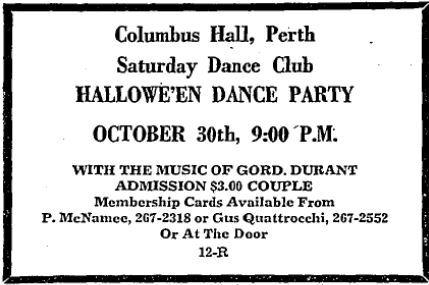
Even the local ladies’ church auxiliary of Calvin United Church, in Bathurst Township, got in on the Hallowe’en fun, deciding to have a Hallowe’en party for the children in the church…
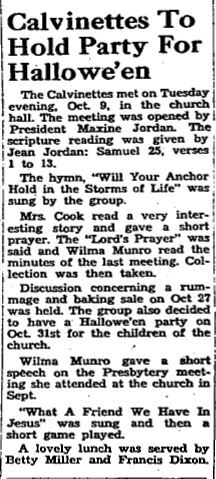
There was lots of local Hallowe’en fun in the neighbouring communities. Innisville School-teacher, Mrs. Mac McLellan knew how to throw a good party for the kids.
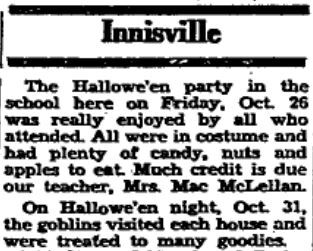
The costumes in the 1960s and 70s, at least in our small communities, tended to be the budget variety. Very few people at that time, in our area, thought that it made much sense to go out and spend a lot of money on a costume that would be worn one night only.
Whether the costumes were for kids, or whether they were for teenagers, or adults for a Hallowe’en dance, the end result usually relied much heavier on imagination than cold hard cash.
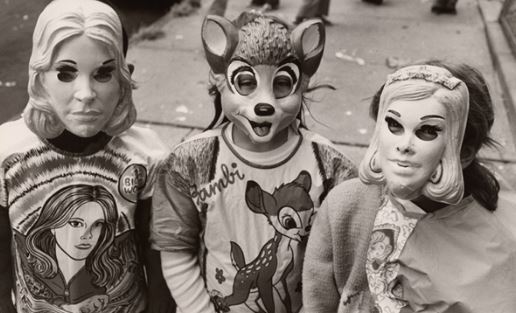
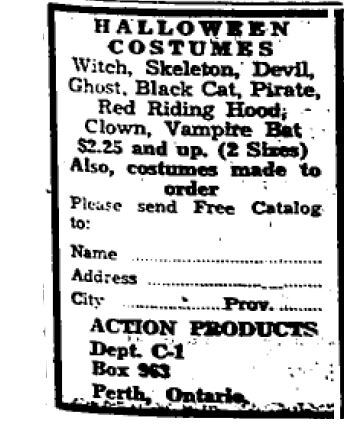
Remember collecting money for UNICEF?
I don’t remember what year it was, that there was suddenly a big ‘push’ for us to collect money (usually pennies) for UNICEF, in place of gathering candy. Being a kid at the time, it didn’t seem like much of a trade-off to come home with a handful of pennies rattling around in a UNICEF box, instead of putting as much candy as possible into the pillowcase I carried around, on Hallowe’en night. I don’t remember anyone explaining where the money was going, or who it was going to. That didn’t help matters.
Well, the kids in Prestonvale were quite the enthusiastic money-collectors, compared to the rest. Imagine in a very small community, where people usually gave a few pennies per UNICEF box, and these kids managed to collect over $11.00. That’s a lot of pennies! I don’t recall anyone ever dropping more than a penny or two, maybe three, into my UNICEF box, in the 60s.
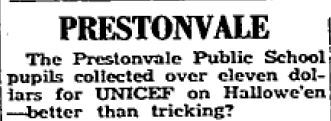
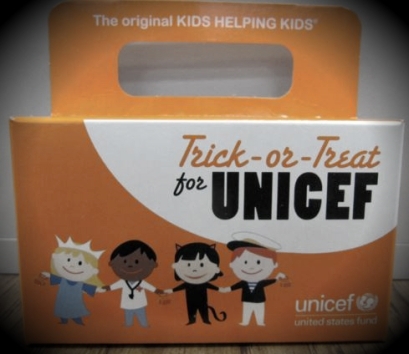
The Hallowe’en mischief in Perth !!!
For a town located so close to farm communities, it’s hard to explain that each year at Hallowe’en there was a real fascination for throwing eggs. I don’t know whether the mischief-makers were buying these at Rubino’s, IGA, or maybe Boles’ or East-End Grocers, but I imagine that there were a lot of local businesses who profited from the sharp rise in egg sales every October 31st.

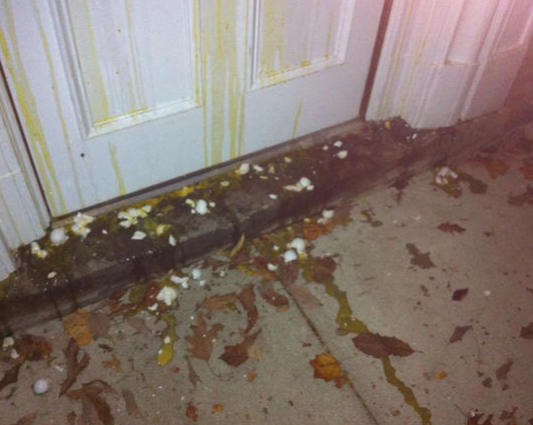
….and this was the front of many local houses

…..and the local car-wash was busy the following day…
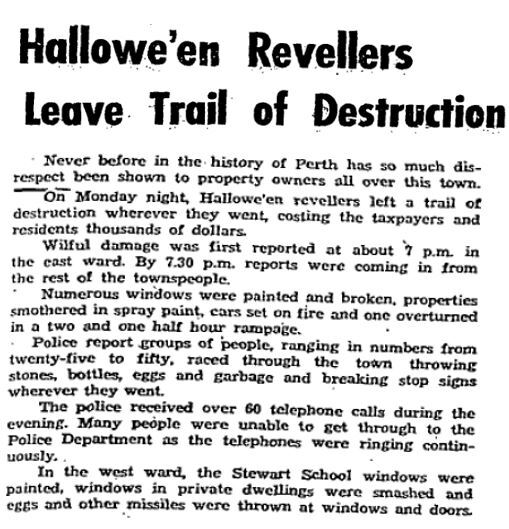
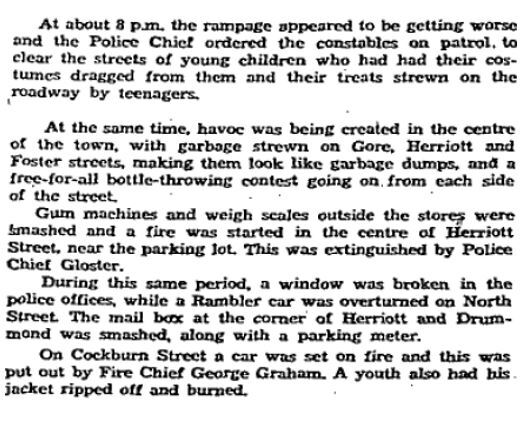
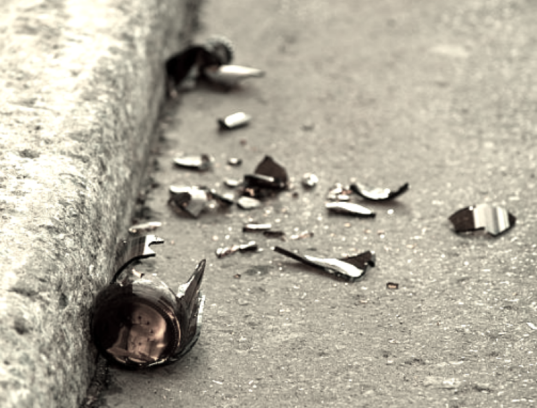
A real mess on Gore Street
….a free-for-all bottle-throwing contest going on from each side of the street

...the most expensive piece of vandalism was a late model car, set on fire on Leslie Street…
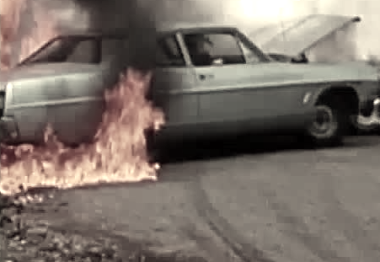
Things continued to escalate into the late 1960s….
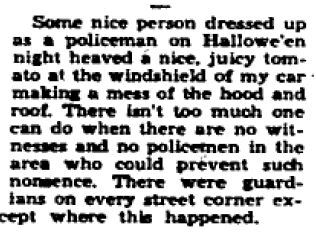
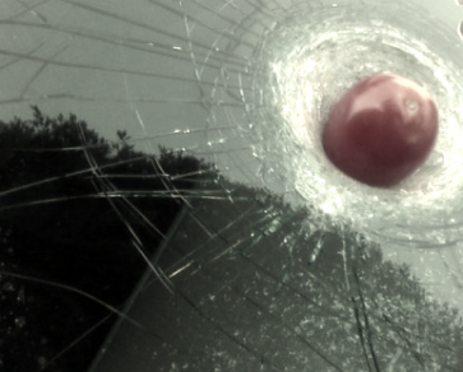
The egg-throwing in Perth became so rampant throughout the 1960s, that by 1968, companies like Andy’s Window Cleaning, were advertising to come and clean-up your windows, the day after Hallowe’en.
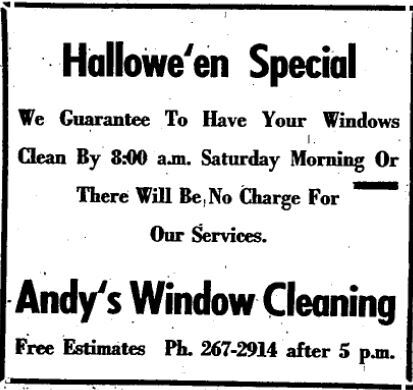
More Shenanigans in the 70s…..
Jim Ewart’s farm became the site for one of the best local Hallowe’en tricks in the 1970s. I don’t know which of our local lads pulled this one off, but they must have had one scary climb up the silo in the dark. Someone had a lot of imagination, but maybe too much time on their hands!
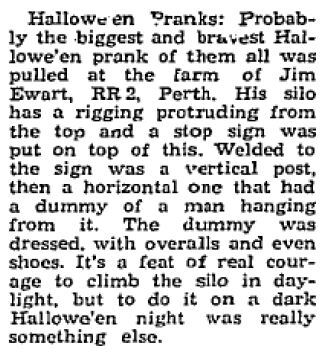
I recall at the time, this particular prank was the talk of the town. In those days, I spent a lot of time in that part of town, so there was much speculation as to which of the lads had pulled this one off. It wasn’t unusual for the boys to climb the water tower in those days, sometimes full of extra bravery, compliments of a night on the town; but it had to require a little extra skill (and maybe some help?) to hang the stuffed dummy so that it was dangling from the tower.
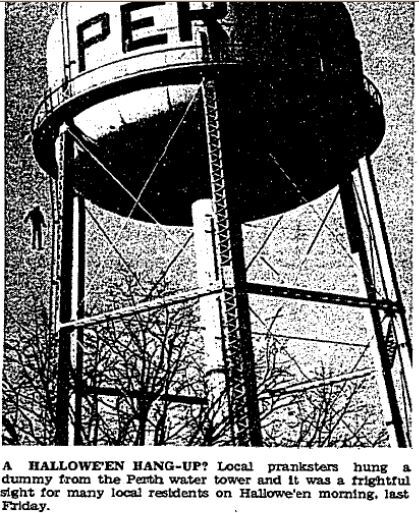
Was Hallowe’en more fun in the 60s and 70s than it is today? Well, if you ask anyone, they will likely say that they enjoyed the Hallowe’en of their youth, no matter what decade it was.
We had a lot of imagination in those days, to make up for the lack of money for fancy costumes and decorations. We never knew what kind of pranks would take place, but we sure became good at dodging flying eggs, while walking down Gore Street.
What do I miss the most? The laughter, the high-spirits, running from house to house, and most of all, I miss the homemade treats!
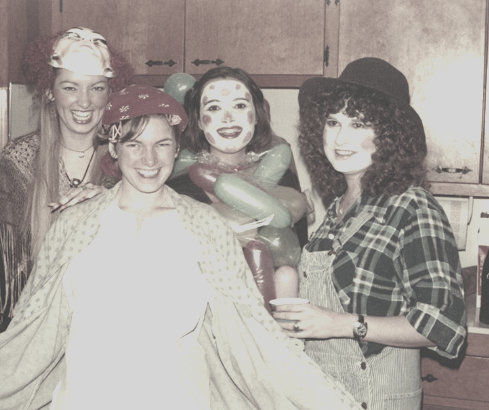
Have a safe and happy Hallowe’en!



